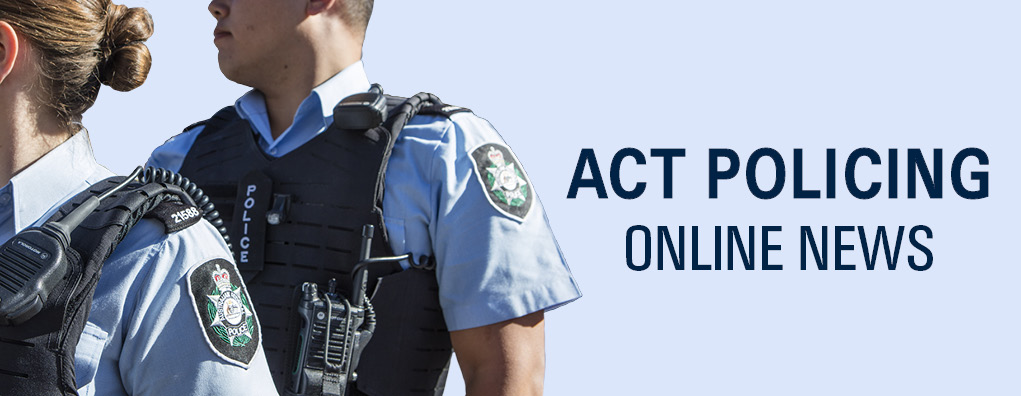ACT Policing: Annual Report 2021-22
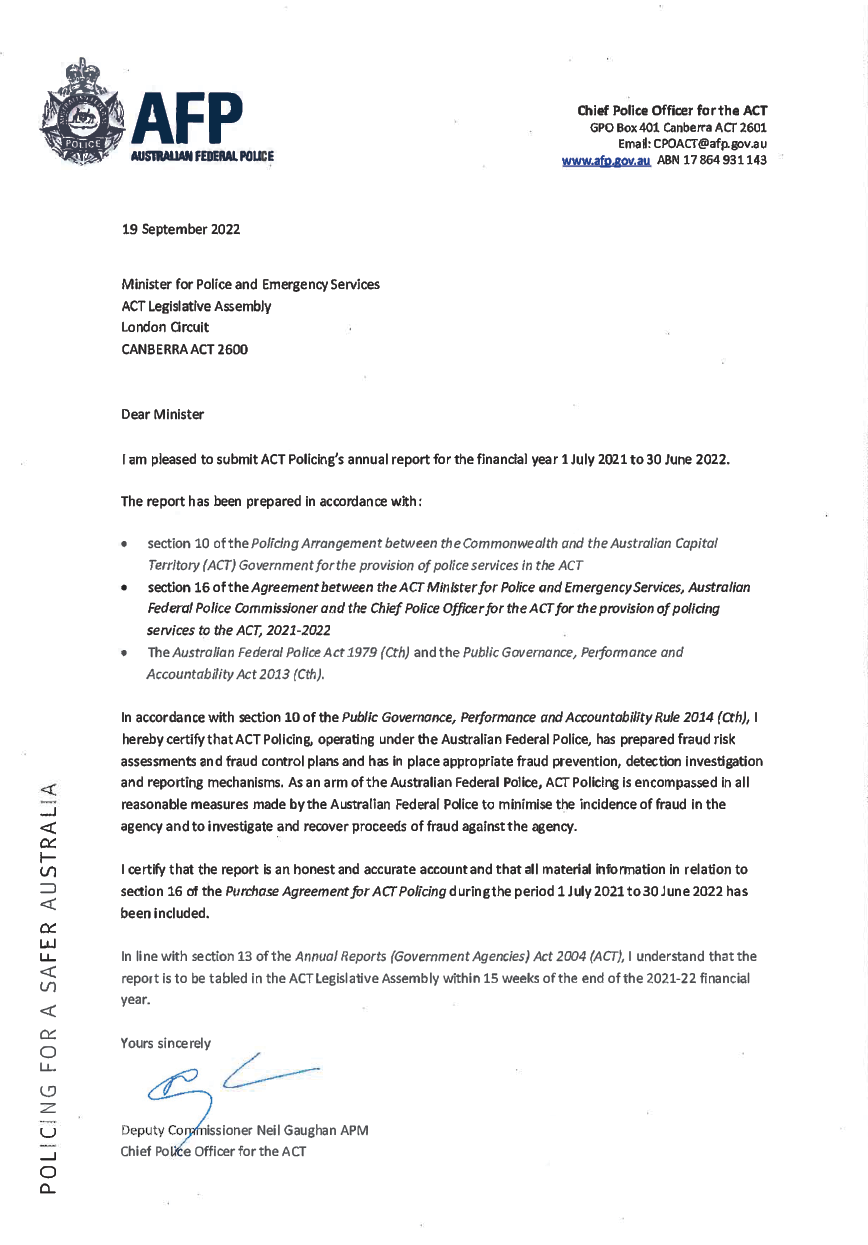
Contents
- 1 Chief Police Officer’s Foreword
- 2 Ministerial Direction
- 3 ACT Policing at a Glance
- 4 Performance Analysis
- 5 Professional Standards
- 6 Use of Force
- 7 Staffing Profile
- 8 Financials
- Appendices
- Appendix 1: Financial Statements
- Appendix 2: Statement of Performance
- Appendix 3: Number of Offences Reported or Becoming Known in Australian Capital Territory 2017–18 to 2021–22
- Appendix 4: Offences Cleared by ACT Policing in the Australian Capital Territory 2017–18 to 2021–22
- Appendix 5: Percentage of Offences Cleared by ACT Policing 2017–18 to 2021–22
- Appendix 6: Proceedings Against Offenders by ACT Policing (Charges) 2017–18 to 2021–22
- Appendix 7: Abbreviations

Ngunnawal Elder Aunty Violet Sheridan performs a Welcome to Country address.
The Australian Federal Police acknowledges the traditional owners and custodians of country throughout Australia and acknowledges their continuing connection to land, sea and community.
We pay our respects to the people, the cultures and the Elders past, present and emerging.
1 Chief Police Officer’s Foreword
It is a privilege to present ACT Policing’s Annual Report for 2021–22 as the Chief Police Officer for the ACT. I am proud to have led ACT Policing through what has been another challenging and demanding year. I am humbled by the resilience, professionalism and dedication shown by my members, and of the results ACT Policing together with the Canberra community have achieved in the 2021–22 financial year.
Building on the momentum of 2020-21, ACT Policing’s transition to the community-focused Police Services Model (PSM) remains one of my key priorities. The operational landscape facing ACT Policing continues to evolve, shaped by the rapidly growing ACT population, expanding land use development and an increasingly complex criminal and social environment. ACT Policing’s transition to the PSM helps address this complexity and demand, and further improves community safety. This model includes strengthening both public and private partnerships to lead a multi-disciplinary response to criminal offending and crime prevention initiatives.
This financial year, ACT Policing focused on the following priority projects under the PSM:
- Under the Proactive Policing capability, a second team has commenced. This increases the ability to focus on problem-solving solutions to reduce the impact of repeat calls for service from the local community.
- The Operational Intelligence Team commenced, introducing a real-time Intelligence capability working within ACT Communications to support the front line and the community. The new capability aligns intelligence products and services to front line members allowing patrols access to intelligence when they need it. The proof-of-concept saw an increase in member safety and efficiency, and reduced operational risk through access to real-time focused intelligence.
- ACT Policing designed and commenced testing a new research and evaluation capability. The role of this capability is to bring new problem-solving methodology from across the world to ACT Policing for use in everyday practices to address systemic crime issues and inform prevention work.
- ACT Policing is exploring a range of modern ways the community can report incidents, crimes and other matters. ACT Policing is committed to maintaining Triple Zero and police assistance phone lines, but is developing complementary online reporting options. Online reporting in the ACT will be introduced through a phased rollout during the 2022–23 financial year to allow for robust community engagement.
Consistent with previous years, 2021–22 placed significant demand on ACT Policing. ACT Policing achieved 13 performance measures and 11 indicators of effectiveness and has continued to focus on crime reduction, crime prevention and community engagement activities.
Despite the increased demand, ACT Policing achieved a number of successful outcomes and initiatives, including:
- Following the success of the Police, Ambulance and Clinician Early Response (PACER) in the ACT, the capability has been expanded to deliver better outcomes for the Canberra community. Providing timely care, delivering at-scene treatment and supporting Canberrans experiencing a mental health incident has been a big success, seeing a significant diversion of patients from hospital Emergency Departments. In the first half of 2022, a delegate from our PACER team travelled to Tasmania and assisted in the development and training of Tasmania’s first PACER cohort. Tasmania Police based their newly developed PACER capability on the ACT PACER model and since they launched their operations in January 2022 they have received ongoing guidance and support from the ACT PACER team.
- In the 2020–21 Budget, the Federal Government provided the Australian Federal Police with $65 million over four years to deliver the SHIELD police healthcare model. During the 2021–22 financial year, the SHIELD rollout commenced in ACT Policing. This commencement has seen the addition of a Registered Nurse, Physiotherapist, Health and Fitness Advisor, Social Worker and the services of a Medical Officer. SHIELD encompasses six elements – Education, Prevention, Early Intervention, Treatment, Transition Support and Centre of Excellence.
- On 10 November 2021, the ACT Policing Operations Committee approved the establishment of Operation Oquendo II in response to an escalating situation which saw high volume recidivist property offenders committing a range of offences across the ACT and NSW, putting the lives of community members at risk. The identified persons of interest were responsible for a significant number of stolen motor vehicles and pursuits during October and early November 2021. Operation Oquendo II ran from 14 November 2021 to 10 February 2022 resulting in the arrests of 22 individuals including 16 adults and six juveniles. The offenders faced a range of serious charges including firearms offences, burglary, take motor vehicle without consent, ride/drive in a stolen motor vehicle, drive at police, fail to stop for police and credit card fraud.
- We are continually looking to improve our response to family violence and work with partner agencies to provide a safer environment for victim survivors. Our Family Violence Unit (FVU) continues to develop the secondary response model to provide a tailored and coordinated approach for both victim survivors and perpetrators of family violence. To achieve this, the FVU is working closely with Child Youth Protection Services, Domestic Violence Crisis Service and Victims Support ACT in sharing information and developing strategies to support victim survivors and hold perpetrators to account.
While COVID-19 continued to challenge our community during the 2021–22 financial year, December 2021 saw one of our largest ever police operations commence in response to protests across Canberra. More than 60 arrests were made in relation to the protest activity – however the overwhelming response from police was to safely manage the activity – at one time involving up to 10,000 protestors. The cost of managing the protests has been in excess of $3.6 million, with more than 42,000 hours of policing resources dedicated to managing protest activity. This equates to more than 5,000 eight-hour shifts.
The ACT tragically experienced 15 road fatalities in the 2021–22 financial year which is higher than the average annual road toll over the last five years. ACT Policing remains committed to lowering the number of serious injuries and fatalities on our roads as much as possible. ACT Policing continues to explore additional mechanisms, including potential legislative reform, to reduce incidents of dangerous driver behaviour in the ACT.
I am proud of the work of ACT Policing. Our people constantly face a challenging and dangerous work environment – they go towards the difficult – it’s an inherent feature of policing. This year has undoubtedly tested their resilience, professionalism and dedication in new ways. They’ve met the challenges they faced and have at all times continued to keep our community safe.
I thank ACT Policing officers for their ongoing dedication and professionalism, the families that support our officers, ACT Government for their continued support, the broader AFP and our partner agencies for working with us to ensure the safety of the community. I look forward to continuing to lead this important work throughout 2022–23.
Deputy Commissioner Neil Gaughan APM
Chief Police Officer for the ACT
2 Ministerial Direction
Minister for Police and Emergency Services Ministerial Direction
This Direction is issued under section 7 of the Policing Arrangement between the Commonwealth and Australian Capital Territory (ACT) Governments and outlines the ACT Government’s priorities and expectations for the Australian Federal Police (AFP) and more specifically the Chief Police Officer for the ACT (CPO). This Direction is to be read in conjunction with the 2021–22 Purchase Agreement between the ACT Minister for Police and Emergency Services, the AFP Commissioner and the CPO. It supersedes and revokes the Direction issued on 10 July 2017.
My primary expectation is that ACT Policing will continue to provide a professional, effective and efficient policing service to the ACT community. This should be achieved through evidence-based and innovative strategies to meet the outcomes of the 2021–22 Purchase Agreement to reduce crime, increase public safety and engage with community and partners locally and nationally.
Through collaborative work with the government and other stakeholders, I expect ACT Policing to play a key role in implementing ACT Government initiatives that improve community safety; reduce harm and trauma; and help prevent, divert and improve outcomes for those in contact with the justice system. This includes being transparent and responsive, as well as working with partner agencies on holistic approaches to complex social issues and providing policing and law enforcement advice to inform government decision making.
In this context, the ACT Government expects ACT Policing will give special focus to the following priorities:
Transitioning to a new policing service model that sees ACT Policing evolving in line with population growth and community expectations by providing a proactive, community focused policing service, centred on the disruption and prevention of crime.
In support of government’s overall efforts to reduce recidivism by 25 per cent by 2025, increase early intervention and diversion strategies and continue to work with the Aboriginal and Torres Strait Islander community to identify ways to reduce the over-representation of Aboriginal and Torres Strait Islander people in the criminal justice system.
Contribute to Canberra as a restorative city and continue to improve responses to vulnerable groups including Aboriginal and Torres Strait Islander people, young people, people experiencing mental health issues, people with a disability, culturally and linguistically diverse people and victims of crime.
Strengthening the ACT’s response to domestic and family violence in appropriate and culturally sensitive ways and supporting the efforts of the Coordinator-General for Family Safety.
Working proactively and innovatively with government to reduce and prevent alcohol-fuelled violence, including enforcing liquor laws, maintaining a presence in night entertainment precincts and responding to alcohol related violent incidents.
Improving road safety, with an emphasis on reducing road trauma experienced by vulnerable road users and combating anti-social and dangerous behaviours including speeding, driving while impaired or distracted.
Disrupting serious and organised crime, including criminal gangs, drug trafficking and supply; and economic disruption to target the proceeds of crime, in addition to working with the government to identify and implement legislative measures to target serious and organised crime.
Drug harm minimisation by continuing to focus on diverting lower level drug offenders from the criminal justice process in accordance with the National Drug Strategy and the Government’s policy settings such as the ACT Drug Strategy Action Plan.
Countering the threat of terrorism and violent extremism by continuing to strengthen the safety of the ACT’s public places in line with national strategies and best practice; and developing a fixated threat capability to meet the government’s obligations under the October 2017 Council of Australian Governments agreement.
I encourage ACT Policing to maintain a diverse and inclusive workforce that is committed to the wellbeing and health of its people so that it can continue to deliver a professional, innovative and effective policing service in a dynamic environment for the ACT community. This will include enhanced digital engagement to ensure ACT Policing continues to evolve in line with community expectations. In support of this, I will continue to work with ACT Policing, the Justice and Community Safety Directorate and the community to support a smooth transition to a new policing service model that will see more police working in a more connected and effective way to disrupt and prevent crime.
Mick Gentleman, MLA
Minister for Police and Emergency Services
28 October 2019
3 ACT Policing at a Glance
Our Role
Through a Purchase Agreement with the Australian Federal Police (AFP), ACT Policing is responsible for providing quality and effective policing services to the people of the Australian Capital Territory (ACT). We do this in partnership with the community and the ACT Government.
Our Mission
Our mission is to keep the peace and preserve public safety within the ACT.
Our Intent
We strive to deliver a professional, innovative and effective policing service in an ever-changing environment for the ACT community.
Our Values
We pride ourselves on being a values-driven organisation. Our core values of integrity, commitment, excellence, accountability, fairness, respect and trust represent our principles and standards — the values we uphold in performing our professional duties.
Our Governance
The key documents which govern the delivery of policing services to the ACT are the Policing Arrangement, Purchase Agreement and Ministerial Direction.
Policing Arrangement
The AFP is a statutory authority established by the Federal Parliament under the Australian Federal Police Act 1979. The AFP delivers policing services to the ACT as a separate outcome under a contractual arrangement between the Commonwealth and the ACT governments.
Purchase Agreement
The Policing Arrangement provides for the negotiation of a Purchase Agreement between the AFP and the ACT Government. The Agreement details the outputs, performance measures, targets, facilities and outcomes to be provided, as well as the powers and obligations of the Minister for Police and Emergency Services, and the Chief Police Officer of the ACT, along with associated administrative arrangements.
The Purchase Agreement defines the three main outcomes against which ACT Policing’s performance is measured:
- Reduce Crime
- Public Safety
- Community and Partner Engagement.
Ministerial Direction
The Ministerial Direction outlines the ACT Government’s priorities for, and expectations of, the Australian Federal Police and the Chief Police Officer of the ACT (see Chapter 2: Ministerial Direction).
Further details of the Policing Arrangement, the Purchase Agreement and the Ministerial Direction are available via ACT Policing’s website at: https://www.police.act.gov.au/about-us/government-directions.
Our Budget
Under the Purchase Agreement, the funding provided by the ACT Government to the AFP for delivery of policing services in 2021–22 was $194.872 million.
The total price includes enabling costs and direct funding from the Justice and Community Safety Directorate (JaCS) for crime prevention initiatives (see Chapter 8: Financial Management Reporting).
Our Approach
Our approach is underpinned by a series of strategies and initiatives that support the outcomes set out in the Performance Measure Framework:
Reduce Crime
- Continued support of the ACT Property Crime Prevention Strategy, by promoting innovative and enduring crime prevention strategies and reducing the opportunities for crime to occur or reoccur.
- Enhancing our response to and the investigation of offences by forging strong relationships with stakeholders to facilitate whole-of-government and cross-jurisdictional information sharing and collaboration.
- Applying technology and forensic science capabilities and effectively using intelligence from a wide range of sources.
- Providing effective and efficient support to the judicial process by maintaining a robust partnership with the ACT Director of Public Prosecutions and delivering high-standard briefs in a timely manner.
- Facilitating a more efficient criminal justice system with an emphasis on timely preventive justice measures and judicial processes.
Public Safety
- Responding in accordance with community expectations, ensuring resources meet demands and enhancing police responsiveness through mobility solutions.
- Effectively planning and managing major events and public demonstrations by reviewing and improving existing arrangements, working with the community and relevant agencies and conducting post-operational assessments for continuous improvement and better practice.
- Working with partners to develop and maintain preparedness in response to emergencies and disasters.
- Improving and promoting road safety through education, innovation and targeted enforcement by working with partner agencies, supporting the ACT Road Safety Strategy and Action Plan and maintaining targets to align with the ACT Road Safety Calendar.
Community and Partner Engagement
- Increasing community trust and confidence in police by communicating in innovative ways with the community, maintaining a social media presence and collaborating with partner agencies, business and community groups to support community events.
- Increasing support for early intervention and diversion by working with partner agencies and community groups to prevent and reduce recidivism.
- Continuing support and delivery in line with the ACT Aboriginal and Torres Strait Islander Agreement 2019–2028 to prevent and reduce the number of First Nations peoples coming into contact with the criminal justice system.
- Supporting the National Plan to Reduce Violence against Women and their Children 2010–2022 and further initiatives that deter, detect and prevent violence against women and children.
- Enhancing and strengthening the resilience of communities through safety and security initiatives and building relationships with vulnerable community groups.
Our Performance
ACT Policing’s performance is measured by the Performance Measure Framework, which incorporates three major outcomes and a series of strategies, initiatives and targets, as articulated in the 2021–2022 Purchase Agreement.
The overarching budgetary outcome of the Purchase Agreement is to work in partnership with the community to create a safer and more secure ACT through the provision of quality policing services. The Performance Measure Framework aims to enhance accountability for the delivery of services, and provide clear links between ACT Policing’s outcomes, outputs, strategies and individual measures. ACT Policing’s three outcomes (Reduce Crime, Public Safety, Community and Partner Engagement) are supported by 21 Performance Measures and 17 Indicators of Effectiveness.
Additional information and results on Performance Measures and the Indicators of Effectiveness are further described in Chapter 4: Performance Analysis.
Our Challenges
Major challenges and demands presented to ACT Policing during 2021–22 included:
- Demand for ACT Policing’s services: COVID-19 compliance enforcement and surge requirements for policing response to ongoing disparate protest activities by diverse issue motivated groups.
- Evolving COVID-19 environment: Continually adapting to the changing police role and supporting the community, to ensure their safety during the COVID-19 pandemic.
- Crime and recidivism: The targeting of recidivism through early intervention and community engagement, in an overall approach to reduce crime in the ACT.
- Family violence: Taking a collaborative approach with the ACT Government and our partner agencies to combat family violence and strengthen the support services available to victims.
- Sexual assault prevention and response: Maintain focus on providing and improving a victim-centric police response to sexual violence in our community, and continuing to work closely with victim support groups to deliver a high level of support and care to victim survivors.
- Serious and organised crime: The prevention and disruption of serious and organised crime through targeting, disrupting and apprehending members of criminal gangs and seizing associated wealth derived from criminal activity.
- Reducing the over-representation of First Nations peoples in the justice system: Ongoing engagement with the local First Nations community to further develop solid, trusting relationships through open dialogue, enhancing our understanding of the challenges faced by First Nations peoples.
- Ensuring safety of ACT Policing members: Increasing the protection for ACT Policing members who are regularly exposed to a risk of assault and/or injury while on duty.
- Increased demand for priority response: In the last five years there has been a 12 per cent increase in critical and time-sensitive calls requiring urgent police attendance, increasing the demand on policing services.
- Mental health and wellbeing of our members: Increasing access to support services to ensure the health and wellbeing of members across ACT Policing.
- Preparing ACT Policing for the future: In order to address the needs of the growing ACT community, we are transitioning to a more community-focused model of police service to meet the current and long-term needs of the ACT community.
Our People
The Chief Police Officer (CPO) is accountable to the ACT Minister for Police and Emergency Services for the achievements and outcomes set out in the Purchase Agreement and Ministerial Direction.
The CPO is also responsible for the management of personnel and resources used to deliver police services to the ACT community. The CPO is supported by four functional streams: Deputy Chief Police Officer, Operations, Investigations and Corporate.
Information about ACT Policing personnel can be found at Chapter 7: Staffing Profile.
FIGURE 3.1: ACT POLICING ORGANISATIONAL STRUCTURE AS AT 30 JUNE 2022
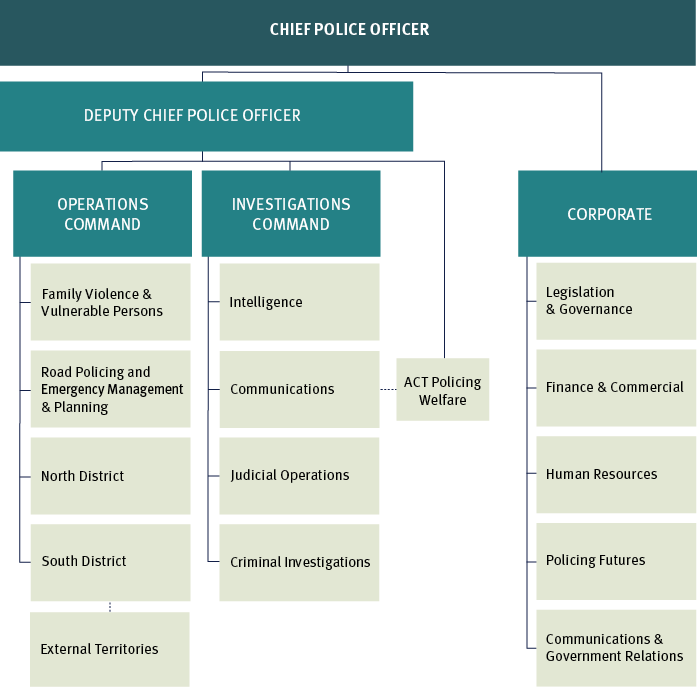
FIGURE 3.2: ACT POLICING PATROL ZONES AS AT 30 JUNE 2022
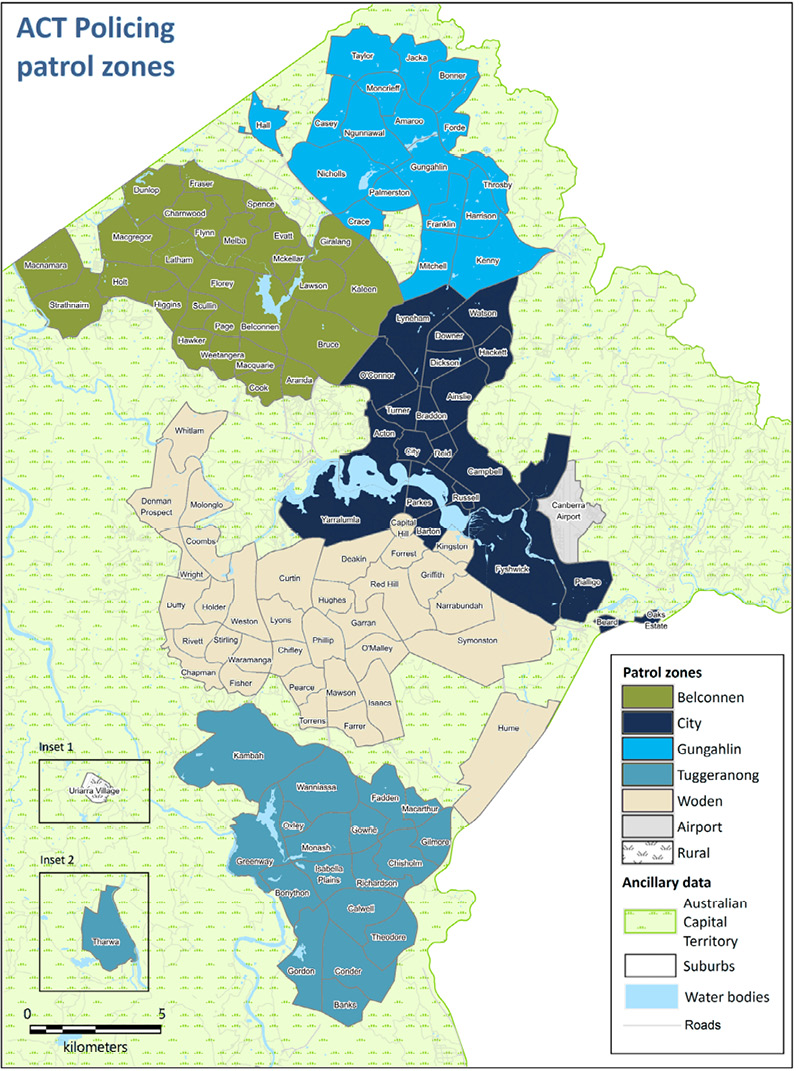
Our Future
At ACT Policing, we are working to evolve with our increasingly dynamic and diverse community to create an even safer Canberra.
Over the past five years the ACT Policing Futures Program has been working to ensure that ACT Policing is ready to deliver a sustainable, efficient and effective policing service to meet the current and long-term needs of the ACT community.
The Police Services Model was funded through a significant $33.9m investment by the ACT Government over four years, with funding commencing in the 2019–20 financial year. The model supports ACT Policing to target resources where they are most effective, conduct focused crime prevention activities and work across the broader justice system with our government and non-government partners to address the root causes of crime.
In 2021–22, the Police Services Model work continued with a focus on priority projects:
- Expansion of the Proactive Policing Capability. The commencement of the second team increased the ability to focus on problem-solving solutions to reduce the impact of repeat calls for services from the local community
- Expansion of the Operationalised Intelligence Capability. The Operational Intelligence team is a critical component of the Police Services Model philosophy focused on promoting an intelligence-led approach to crime attendance in the ACT. This capability provides members with rapid intelligence to assist in tactical decision making, enquiries and investigations so they can better focus on the job and priorities at hand.
- Designed and commenced testing of a Research and Evaluation Capability. The role of this capability is to bring new problem-solving methodologies from across the world to ACT Policing and utilise in our everyday practices to address systemic crime issues and inform prevention work.
- Continued work on the community-focused Online Reporting Portal so members of the community have access to alternative reporting options when they encounter non-urgent crime.
Case Study
Expansion of the Police, Ambulance and Clinician Early Response
Following the success of the introduction of the Police, Ambulance and Clinician Early Response (PACER) in the ACT, the program was expanded.
The PACER model aims to create a safer, more dignified platform for providing emergency mental health intervention by offering therapeutic and less restrictive options for patients.
This model not only empowers patients to actively take part in making informed decisions about their health and care, but it has also shown tangible results, including an increase in patients being linked in with appropriate support services, a reduction in use-of-force incidents involving mental health patients, a reduction in hospital presentations and involuntary admissions, and a decrease in the demand for front-line emergency resources.
In the 2021–22 financial year, PACER attended 1,602 cases, an average of four per shift. PACER was the first responder in 57 per cent of these cases. Providing timely care and delivering at-scene treatment has resulted in 70 per cent of patients attended to by PACER receiving care in their home, diverting them from hospital placement.
Additionally, PACER was only required to enact Emergency Apprehension provisions of the ACT Mental Health Act 2015 for approximately 10 per cent of people it assessed. Of those who were transported to a hospital emergency department by PACER, over two-thirds were admitted to an inpatient unit; and less than 1 in 10 people assessed by PACER who remained in the community, were subsequently admitted to hospital in a two-week period following PACER contact.
When considered together, these results indicate that PACER is:
- reducing demand on police, ambulance, emergency departments and acute mental health inpatient units by foregoing the need to transport people to hospital emergency departments for further assessment and/or admission
- exercising clinically appropriate judgments and decision-making in terms of who is transferred to hospital and who can safely remain in the community following PACER contact
- limiting the use of restrictive practices for people experiencing acute mental health concerns.
PACER is not a support service for ongoing care or referrals from medical practitioners. It is a responsive, multi-agency, acute mental health intervention service for cases that are typically referred to ACT Policing and/or ACT Ambulance Service.
ACT Policing review referrals to assess for multiple factors, such as mental health concerns, urgency of response, the degree of risk concerning harm to self and others, physical health concerns, existing involvement with Canberra Health Services, and whether a PACER response would be helpful. The assessment determines whether, when, and how PACER will respond.
PACER is a commitment by ACT Policing, ACT Ambulance Services and Canberra Health Services within the ACT which started in December 2019. In early 2022 a six-month trial was funded to create a second team, seeing the increasing service deliver a day shift from 8am to 6pm, in addition to the existing afternoon shift of 2pm to 12am, seven days a week. The value of a second PACER unit has been recognised, with funding for the capability extended through the 2022–23 financial year. During their hours of availability, each PACER unit is staffed by a police officer, a paramedic and a mental health clinician.
Case Study
ACT Policing introduces electronic Court Attendance Notices
The ACT Policing Judicial Operations Business and Capability Team is delivering key improvements to processes and governance as well as new capabilities to support members and transition the way we provide services to the community.
The introduction of electronic Court Attendance Notices (CANs) aims to ensure a more efficient and effective way of advising people of their court attendance and allowing ACT Policing to expedite court proceedings.
A CAN is a formal notice requiring a person to attend court to respond to charges against them. The digitisation of this process will enable members of ACT Policing who identify a relevant offence to select a court date and complete the CAN using the current infringement technology.
ACT Policing Judicial Operations and Road Policing commenced a trial in January 2022 where CANs were issued to eligible traffic offenders, reducing the need of a summons being served, and contributing to ACT Policing’s strategy of using technology to support frontline members.
From commencement of the trial to 30 June 2022, 122 CANs were issued by ACT Policing. While the initial trial focused on drink-driving related offences, the issuing of CANs has gradually evolved, and now covers additional road offences.
On 26 January a 41-year-old O’Connor man was issued with the first CAN for drink driving. It took police roughly 45 minutes from the time the offence occurred, to being able to serve the notice. The offender signed the document at the station and was given a court date of 16 February 2022. This meant there was no follow-up required by the Service and Process Team to advise the offender of when he was required to appear.
By 16 February 2022, the first electronic CAN was successfully processed and finalised through the ACT Magistrates Court. It took 21 days in total from when the offence occurred to its finalisation, which is a quick outcome for all parties involved.
Electronic CANs are an important step forward for ACT Policing, as they remove the cumbersome requirement for a police officer to locate an offender and serve a summons, providing clear and timely information to the offender. Should an offender fail to appear at court for an indictable offence, a bench warrant may be issued by the court which removes additional paperwork from the workload of ACT Policing members.
Continuing to reduce red tape for its members is a key priority for ACT Policing. An electronic CAN progresses a matter from issuance to first appearance in a much faster manner than a summons. Efficiency in expediting matters is a positive outcome for all parties involved, including the courts, Department of Public Prosecutions, police, victims and members of the public who are issued these notices. The Business Capability and Improvement Team has worked hard to deliver this initiative to ensure a seamless transition to the new concept for all ACT Policing members.
Case Study
Expanded Use of Body Worn Cameras
On Friday 11 February 2022, amendments to the Crimes (Surveillance Devices) Act 2010 (ACT) and publicly available guidelines took effect, meaning attending police officers are now able to use their Body Worn Cameras (BWC) to record in private settings without the requirement to seek consent.
The new publicly available guidelines are an instrument issued by the Chief Police Officer, as required by the legislation. A new Better Practice Guide providing greater clarity for police officers has been developed to ensure all police officers have a clear understanding of the new legislation.
What has changed and what does this mean for police officers? And importantly, what does this mean for the general public?
While the day-to-day use of BWCs hasn’t greatly changed, the legislative amendments and new guidelines provide broader powers in the use of the BWC. However, with this broader use comes greater limitations on officer discretion for when they must be used.
In the past, where police officers could use their BWC’s where reasonably necessary and justified, police officers now must use their BWC’s unless a justifiable exception exists. The default position is that a BWC is always on and recording when engaging with a member of the public in an operational setting.
Now, if the BWC is not recording, the onus is on the police officer to justify why.
Apart from the exceptions below, the other key change is police officers must (subject to certain conditions) notify a person interacting with police that the BWC is recording, in both private and public spaces.
Like current arrangements, police officers must have their BWC turned on and ready to record both when outside designated areas (stations), and when interacting with members of the public in most circumstances.
Specific examples are now included when BWCs must be used. These situations include, but are not limited to:
- use of force incidents – when reasonably able to unless a firearm is drawn or conducted electrical weapon (CEW) armed (automatic activation)
- when engaging with the public while investigating a crime, in both public and private spaces
- traffic stops
- serving documents
- any other execution of police powers, including arrest, search and seizure.
4 Performance Analysis
2021–22
COMMUNITY POLICING
| arrests made | 3,737 |
|---|---|
| family violence incidents attended | 3,073 |
| summons issued | 1,500 |
| intoxicated persons lodged in protective custody | 767 |
| cautions issued | 303 |
INTERVENTION
| referrals to community support agencies | 5,567 |
|---|---|
| drug seizures | 928 |
| people diverted into Early Intervention and Drug Diversion Program | 112 |
| number of diversionary conferences | 78 |
ORDERS AND BRIEFS
| Family Violence Orders | 1,024 |
|---|---|
| Personal Protection Orders | 1,036 |
| hearing briefs delivered to the Director of Public Prosecutions | 1,305 |
MEDIA
| media enquiry responses provided | 1,166 |
|---|---|
| media releases issued | 450 |
ACT POLICING WEBSITE
| unique page views for police.act.gov.au | 423,833 |
|---|---|
| unique page views for policenews.act.gov.au | 1.22M |
| media subscribers | 2,761 |
| news subscribers | 1,391 |
| community blog subscribers | 1,641 |
SOCIAL MEDIA
| followers on Facebook | 142,475 |
|---|---|
| followers on our Twitter channels (ACT Policing and ACT_Pol Traffic) | 64,814 |
| Instagram followers | 20,365 |
| impressions on Facebook | 41.64M |
| impressions on our Twitter channels | 3.48M |
| impressions on Instagram | 2.05M |
Note: Impressions are the number of times a post from your page is displayed, regardless of whether it was clicked on or engaged with or not. For example, if someone sees a page update in their Facebook newsfeed and then sees that same update when a friend shares it that would count as two impressions.
COMMUNITY ENGAGEMENT
| community requests facilitated 1 | >25 |
|---|---|
| community events attended 1 | 29 |
CONSTABLE KENNY KOALA PROGRAM
| classroom presentations 2 | 890 |
|---|---|
| students visited 2 | 20,924 |
| community events attended 2 | 5 |
| unique page views for Constable Kenny website | 21,018 |
Performance Measures
ACT Policing, in partnership with the ACT Government and the community, aims to create a safer and more secure ACT through the provision of a quality community policing service.
The Purchase Agreement outlines 21 performance measures under three main outcomes, against which ACT Policing’s performance is measured.
| Outcome | Outputs |
|---|---|
| Reduce Crime | Crime Prevention and Reduction |
| Criminal Investigations and Prosecutions | |
| Public Safety | Police Response |
| Public Order and Emergency Management | |
| Road Safety and Traffic Management | |
| Community and Partner Engagement | Community Support and Whole-of-Government Collaboration |
The Purchase Agreement also outlines 17 Indicators of Effectiveness (IoE) that measure public perceptions of crime, public confidence in police, road safety, and crime prevention through the National Survey of Community Satisfaction with Policing.
A full summary of all offences reported and cleared by ACT Policing, in addition to the number of proceedings against offenders, can be found at Appendices 3 to 6.
ACT Policing achieved or exceeded 13 of the 203 Performance Measures, and 11 of the 164 IoE as outlined in the Purchase Agreement.
Indicators of Effectiveness
The IoE framework was introduced in the 2014–15 Purchase Agreement to separate the indicators contained within the framework from the Performance Measure Framework. This recognises that the performance outcomes for these indicators are not fully within ACT Policing’s control. There are a number of public and private institutions and individuals who contribute to the overall results and standings in these indicators.
The National Survey of Community Satisfaction with Policing (NSCSP) is a telephone survey (landline and mobile telephone numbers) which measures community perceptions on a range of policing-related issues. These issues include satisfaction with policing services, feelings of safety, concern about potential victimisation and beliefs about police behaviour. During 2021–22, 2,402 ACT residents participated in the survey, with 27,926 participating nationally. This survey relates to 16 IoE and two Performance Measures.
The survey monitors community concern about becoming a victim of certain crime types. While these series of questions can elicit a variety of interpretations, ranging from an assessment of likelihood of victimisation through to an assessment of how the victim would feel if they were to become a victim, the indicators are the best available for fear of crime.
It is important to note that while we aim to reduce the level of fear of crime in the community, there are some positive aspects to the community having some level of awareness of crime in their neighbourhood. A level of awareness can contribute to crime prevention behaviours and potentially lower the chances of victimisation.
ACT Policing undertakes education and prevention strategies, and works with community organisations to educate members of the community on personal and property safety, and measures that can be put in place to mitigate the risk of becoming a victim of crime. This, in turn, provides reassurance and reduces the level of fear in the community.
NSCSP results relevant to the IoE for 2021–22 can be found in Appendix 2.
The following data outlined in this chapter provides an overview of each performance measure against the 2021–22 target, the achieved result, and the reason for variation, if any.
Data for the selected performance measures and comparison tables was extracted from ACT Policing’s case management system (PROMIS) on 4 July 2022. It is important to note that ACT Policing’s database is live and crime data is continually revised, therefore crime statistics may differ depending on the date of extraction.
Outcome: Reduce Crime
Crime Prevention and Reduction
Performance Measure 1 — Number of offences against the person reported or becoming known per 100,000 population
Offences against the person include but are not limited to, homicide and related offences, sexual assault offences, assault offences and other offences against the person.
The target for this measure was 800 or fewer offences against the person reported or becoming known per 100,000 population. ACT Policing did not meet the target for this measure recording a result of 801.8 offences per 100,000 population, over the target by 0.2 per cent.
Typically, person offences, particularly incidents of family violence and sexual assault, are under reported. Changes in the number of person offences reported can be representative of a cultural shift in willingness to report.
ACT Policing launched the Historical Sexual Assault Online Reporting portal in August 2020 enabling victim survivors to make informed decisions about their disclosure for historical sexual assaults (offences that occurred more than six months ago). The portal complements existing reporting avenues and outlines what level of information is required for such proceedings and gives victim survivors the choice to proceed with a criminal investigation or not. Victim survivors can report any incident of sexual assault to police, regardless of how long ago it occurred. It is not uncommon for victim survivors to be unwilling to support an investigation of their matter and for court proceedings to follow. The online reporting portal is a step towards giving victim survivors more control over what happens next and the assurance that the information they provide will be managed sensitively and securely.
FIGURE 4.1: OFFENCES REPORTED AGAINST THE PERSON 2012–13 TO 2021–22
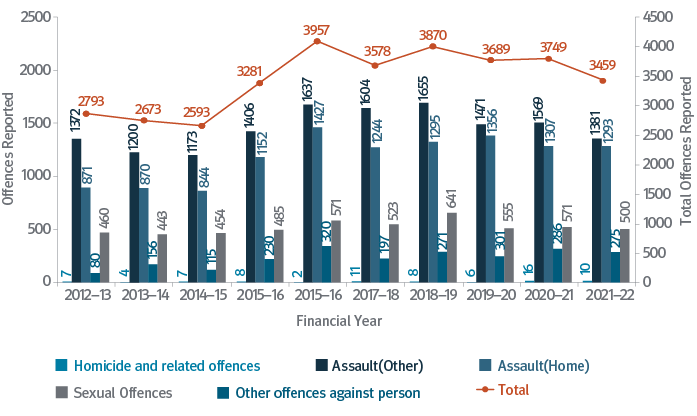
Source: PROMIS as at 4 July 2022
During 2021–22 there were 3,459 offences against the person reported to ACT Policing. This represents a decrease of 7.7 per cent (or 290 offences), compared to 2020–21.
TABLE 4.1: OFFENCES AGAINST THE PERSON BY OFFENCE TYPE – FINANCIAL YEAR COMPARISON
| Offences type | 2020–21 | 2021–22 | Change |
|---|---|---|---|
| Homicide and related offences | 16 | 10 | -37.5% |
| Sexual Offences | 571 | 500 | -12.4% |
| Assault | 2,876 | 2,674 | -7.0% |
| Assault (Home) | 1,307 | 1,293 | -1.1% |
| Assault (Other) | 1,569 | 1,381 | 12.0% |
| Other offences against person* | 286 | 275 | -3.8% |
| Total | 3,749 | 3,459 | -7.7% |
Source: PROMIS as at 4 July 2022
*Other offences against the person include kidnapping and abduction, threatening behaviour and other dangerous and negligent acts.
During 2021–22, overall assault offences decreased by 7 per cent when compared to 2020–21.
Of those assault offences reported to ACT Policing, 46.4 per cent were family violence related, as shown in Figure 4.2.
FIGURE 4.2: PROPORTION OF FAMILY VIOLENCE RELATED ASSAULTS 2012–13 TO 2021–22
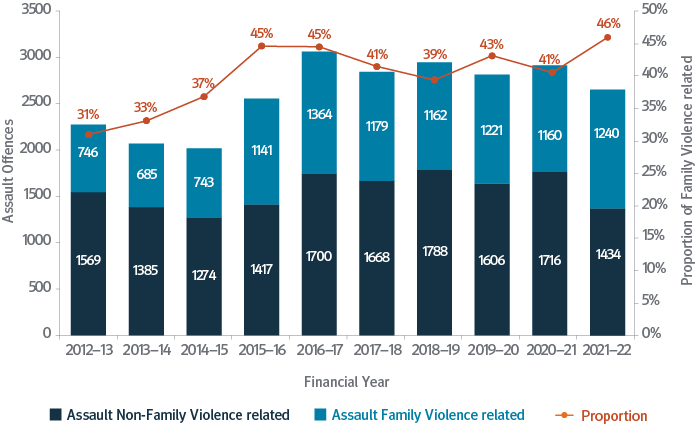
Source: PROMIS as at 4 July 2022
Family violence related assaults have increased by 6.9 per cent over the 2021–22 financial year. Long term trends over 10 years show an increase of 77.9 per cent, over this period the ACT population has increased by 20 per cent.
ACT Policing’s Family Violence Unit (FVU) reviews all ACT family violence incidents, triaging each incident to coordinate a secondary response with appropriate support and action. To improve engagement with general duties members, the FVU visits each police station once a week to share expertise.
The FVU’s focus is on continuing to develop its secondary response model to provide a tailored and coordinated approach for both victim survivors and perpetrators of family violence. To achieve this, the FVU works closely with Domestic Violence Crisis Service, Child and Youth Protection Services and Victims Support ACT in sharing information and developing strategies to support victim survivors and hold perpetrators to account.
Figure 4.3 shows the percentage of people in the ACT somewhat concerned or very concerned about becoming a victim of certain crime types compared to the national average.
FIGURE 4.3: PERCEPTION OF CRIME BY OFFENCE TYPE 2021–22
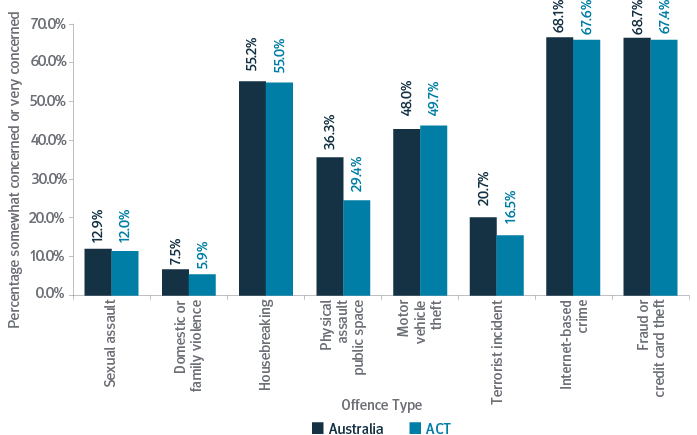
Source: National Survey of Community Satisfaction with Police, 4 July 2022
The results shown in Figure 4.3 are promising. When compared to the national average the ACT had a lower percentage of people who are concerned about being victims of sexual assault, domestic or family violence, housebreaking, physical assault in a public place, a terrorist incident, internet based crime and fraud.
Figure 4.4 depicts the percentage of people who feel safe by location and time of day. When compared to the national average the ACT had a higher proportion of residents who felt safe while travelling on public transport and walking alone during the day and night.
FIGURE 4.4: FEELINGS OF SAFETY BY LOCATION AND TIME OF DAY 2021–22
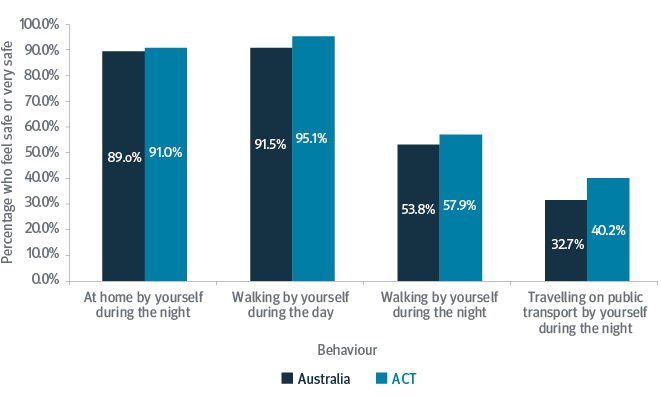
Source: National Survey of Community Satisfaction with Police, 4 July 2022
Case Study
National Firearms Amnesty
Committed to ensuring Canberra remains a safe city, ACT Policing participated in the National Firearms Amnesty to remove unregistered and unwanted firearms from the streets of its community.
Firearms feature prominently in the most violent of crimes including murder, shootings causing serious injuries, armed robbery, threats to kill and extortion. They are also the object of targeted burglaries – posing a significant risk to the community when used unlawfully.
Firearms cause harm to victims and impact the victims’ friends and family. Their unlawful use in a community erodes confidence, sense of safety and wellbeing.
On 5 July 2021, Minister for Police and Emergency Services Mick Gentleman, ACT Region Crime Stoppers Chair Diana Forrester and Acting Chief Police Officer for the ACT Elizabeth McDonald launched the National Firearms Amnesty in the ACT and encouraged those in possession of an unwanted or illegal firearm to surrender it during the amnesty period.
The Amnesty afforded individuals who possessed an unregistered firearm or firearm-related item the opportunity to surrender it to police without penalty, for registration, sale or destruction.
With more than 500 weapons surrendered to ACT Policing including rifles, shotguns, handguns and a gel blaster, the first phase proved highly successful. Phase two focused on continuing this success, with increased efforts around community engagement and information sharing.
Launching on 25 February 2022 the second phase encouraged Canberrans to report individuals who they suspected were in possession of an illicit firearm. 109 reports to Crime Stoppers have been received since 1 July 2021, providing vital information to police.
As at 30 June 2022, 830 items were surrendered, making Canberra an even safer place to live. Items included:
- handguns
- rifles
- shotguns
- gel blasters
The ACT Firearms Registry also received a flame-thrower, a number of World War One era rifles and a 100-year-old former United States military pistol. Surrendered firearms of historical significance were offered to museums to form part of their collections.
Due to its success the ACT Government passed legislation in 2022 to make the National Firearms Amnesty permanent.
Case Study
Operation Yasen: prominent restaurateur arrested for money laundering
An extensive long-term investigation by ACT Policing’s Criminal Investigations has resulted in an acclaimed Canberra chef pleading guilty to charges of perjury and money laundering, in a case highlighting the continued success of ACT Policing in targeting and disrupting organised crime activities in Canberra.
In August 2021, search warrants were executed at residences in Bonner and Holt, and at a renowned restaurant in the Canberra City precinct.
Significant evidence was collected at the search warrants including more than $135,000 in cash, a gel blaster firearm, a commercial money counter, electronic devices and a quantity of steroids.
Under proceeds of crime legislation, police restrained the Bonner residence, a white Lamborghini coupé, a BMW 4-series sedan and a grey Ford Ranger, as well as several bank accounts. The approximate value of all restrained items was more than one million dollars.
In March 2022, the 49-year-old man appeared in the ACT Magistrates Court where he pleaded guilty to money laundering, perjury, general dishonesty – influence public official, make false evidence and obtain property by deception
The man was released on bail and appeared in court at a later date.
The outcomes of this operation showcase ACT Policing’s continued efforts in successfully dismantling organised crime networks and those in the Canberra community who support this criminal activity. ACT Policing as part of the broader AFP’s efforts to maximise our impact on the criminal environment will continue to target criminal assets as part of our broader enforcement actions.
Performance Measure 2 – Number of offences against property reported or becoming known per 100,000 population
Offences against property include but are not limited to robbery, burglary, motor vehicle thefts, other theft, property damage and other offences against property.
The target for this measure was 8,300 or less offences against property reported or becoming known per 100,000 population. ACT Policing achieved the target for this measure with a result of 3,961.5 offences per 100,000 population.
FIGURE 4.5: OFFENCES REPORTED AGAINST PROPERTY 2012–13 TO 2021–22
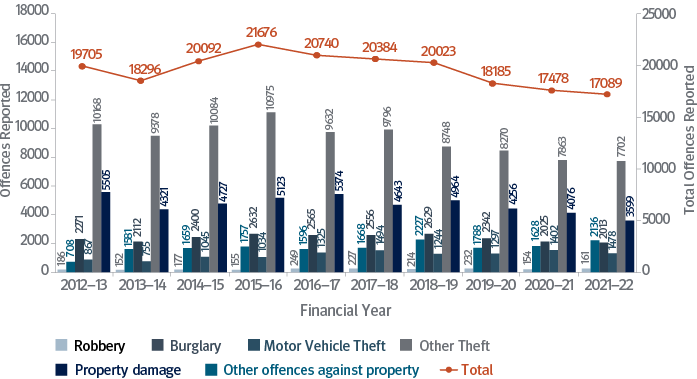
Source: PROMIS as at 4 July 2022
During 2021–22 there were a total of 17,089 offences against property reported to ACT Policing. This represents a decrease of 2.2 per cent (or 389 offences) when compared to 2020–21.
TABLE 4.2: OFFENCES AGAINST PROPERTY BY OFFENCE TYPE – FINANCIAL YEAR COMPARISON
| Offences type | 2020–21 | 2021–22 | Change |
|---|---|---|---|
| Robbery | 154 | 161 | 4.5% |
| Armed robbery | 61 | 79 | 29.5% |
| Unarmed robbery | 93 | 82 | -11.8% |
| Burglary | 2,025 | 2,013 | -0.6% |
| Burglary dwellings | 1,172 | 1,086 | -7.3% |
| Burglary shops | 289 | 387 | 33.9% |
| Burglary other | 564 | 540 | -4.3% |
| Motor Vehicle Theft | 1,402 | 1,478 | 5.4% |
| Other Theft | 7,863 | 7,702 | -2.0% |
| Property damage | 4,076 | 3,599 | -11.7% |
| Other offences against property* | 1,958 | 2,136 | 9.1% |
| Total | 17,478 | 17,089 | -2.2% |
Source: PROMIS as at 4 July 2022
*Other offences against property include fraud and misappropriation, handling of stolen goods, environmental offences, blackmail and extortion and other property offences not elsewhere classified.
Figure 4.6 shows that motor vehicle theft offences reported in the ACT have increased year on year since the 2018–19 financial year. ACT Policing in partnership with the ACT Government continues to promote property crime reduction strategies to the community. The Outsmart the Offender campaign provides practical ideas that can be implemented to reduce the risk of motor vehicle theft and other property crime offences.
FIGURE 4.6: MOTOR VEHICLE THEFT OFFENCES REPORTED 2012–13 TO 2021–22
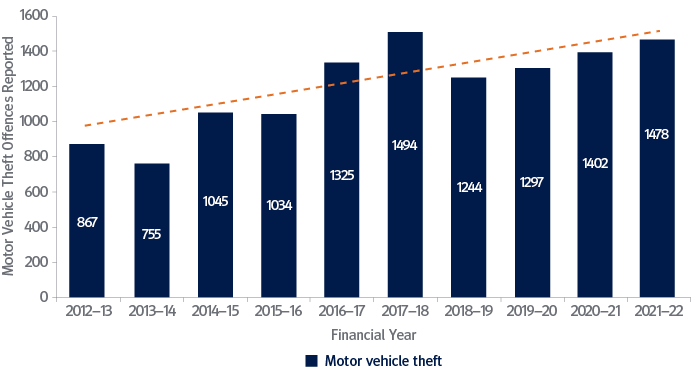
Source: PROMIS as at 4 July 2022
Criminal Investigations and Prosecutions
Performance Measure 3 – Percentage of offences against the person cleared
Offences cleared relates to offences where there is an outcome during 2021–22. These outcomes include the identification of an offender (through an arrest or some other form of proceeding such as a summons or a caution), withdrawal of the complaint or the determination that the offence was unsubstantiated. It is important to note the clearance of the offence may not necessarily occur in the same period in which it was reported.
The target for this measure required a clearance rate of 72 per cent or more for all offences against the person. ACT Policing did not meet the target for this measure recording a clearance rate of 68.8 per cent.
FIGURE 4.7: OFFENCES REPORTED AGAINST THE PERSON CLEARED 2012–13 TO 2021–22
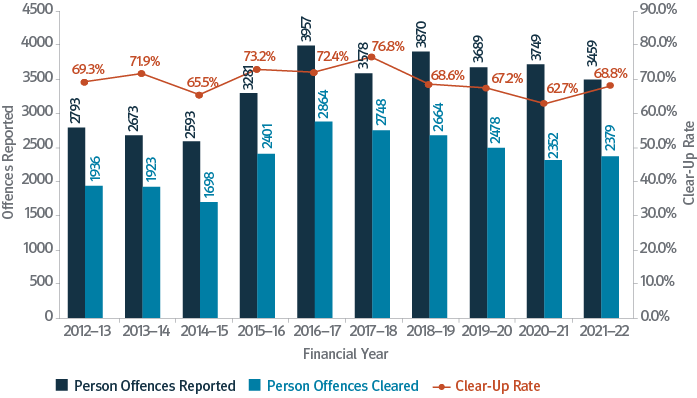
Source: PROMIS as at 4 July 2022
Case Study
Taskforce Nemesis
Taskforce Nemesis is a dedicated team embedded within ACT Policing’s Criminal Investigations. The Taskforce targets the criminal activities of gangs and, together with the Criminal Assets Investigation Team, unexplained wealth in order to disrupt and dismantle illegal activity.
On 23 July 2021, police located two men inside a residential garage in Bonner along with approximately 120 grams of cocaine, a large sum of cash and more than 1,000 rounds of ammunition which were seized.
In October 2021 members of Taskforce Nemesis became aware of intelligence that indicated one of the men, a known close associate of a senior Canberra-based Rebels Outlaw Motorcycle Gang member, had come into possession of a firearm.
This intelligence was fed into an ongoing investigation into outlaw motorcycle gang (OMCG) drug distribution in the ACT and the surrounding region.
A search warrant was executed on the 31-year-old man’s residence in the suburb of Ngunnawal by Taskforce Nemesis members, assisted by Major Crime members from Gungahlin, AFP Canine and AFP Imagery & Geomatics.
The search located a loaded sawn-off .410 shot gun, along with ammunition and a bandolier. These items had been stored in plain sight and were immediately seized. Also seized during the warrant were an imitation firearm ‘gel-blaster’ and a quantity of methylamphetamine.
As the investigation progressed, Taskforce Nemesis members arrested a 46-year-old man located in a vehicle in Braddon in November 2021. When a search warrant was subsequently executed at his residence, members located approximately 60 grams of cocaine, approximately $15,000 in cash and a prohibited weapon (a set of knuckle dusters). These items were seized, along with a Holden Commodore and a Renault work van believed to be purchased with the proceeds of crime.
The 46-year-old was charged with trafficking in a controlled drug (other than cannabis), possession of a prohibited weapon and failing to comply with an order to unlock electronic devices.
On 15 December, Taskforce Nemesis detectives arrested the 31-year-old resident of the suburb of Ngunnawal and charged him with attempted trafficking of a controlled drug (other than cannabis), possession of ammunition and two counts of possessing prohibited firearms.
Subsequently, the 46-year-old faced additional charges including two counts of attempted trafficking in a controlled drug (other than cannabis), cultivation of cannabis for sale, and two counts of possession of property suspected of being proceeds of crime.
Court proceedings against both men are continuing, with trials expected to commence towards the end of 2022.
Case Study
Operation Pike: protests and arson at Old Parliament House
Throughout 2020 and 2021 cities across Australia experienced a range of protest activity, largely held by protesters focused on perceived loss of freedoms and mandatory vaccination requirements in response to the COVID-19 pandemic. During that time, associated protests in Canberra were generally infrequent and far smaller.
This started to change late in 2021, when both the frequency and impact of protest activities in Canberra began to increase.
By 17 December, Old Parliament House had become a focal point for this protest with daily demonstrations being held in the vicinity. A number of Issue Motivated Groups (IMGs) elected to set up camp in parkland near the Aboriginal Tent Embassy and indicated they were planning to ‘take possession’ of Old Parliament House.
While the protest activity occasionally pushed the boundaries of what would be considered peaceful, around this time only a handful of arrests were made for relatively minor infractions.
However, during protest activities on 21 December 2021, a small fire was started atop the front steps of Old Parliament House. It was quickly extinguished by police and emergency services and the protesters were directed to move on.
On the morning of Thursday 30 December 2021, an IMG stoked a fire being used in a ‘smoking ceremony’ at the main entrance to Old Parliament House using their overwhelming numbers of protestors to obstruct police, preventing immediate police action. These actions resulted in the doors and historical portico at the front of the building being set alight, causing damages that would cost several million dollars to repair.
The significance of the fire generated media attention at local, national and even international levels, and within only a few hours, dozens of media outlets had representatives at the scene seeking comments from ACT and Federal Government spokespeople.
While the fire was extinguished quickly, the events of that day set in train an investigation that remains active, with the establishment of Operation Pike, a joint taskforce consisting of both AFP and ACT Policing investigators.
The investigation commenced immediately and yielded rapid results. Investigators gathered forensic evidence from the scene, conducted a comprehensive analysis of video footage gathered from CCTV systems and social media, and quickly identified several persons of interest.
By 1 January 2022, three people were arrested for assaulting and hindering police at the time of the fire. The next arrest was the first in relation to setting the fire and was made the following day, with five subsequent arrests in the ensuing months. Court proceedings continue for the six accused, on a total of 21 charges.
Case Study
Operations Hawker and Petteia: the most sustained protests since the 1990’s
The summer of 2021–22 in Canberra saw the usual influx of Summernats supporters, but also significant protest activity – on a scale not seen in the ACT for many years.
Beginning in December 2021, a small group of campers gathered opposite the long-established Aboriginal Tent Embassy in front of Old Parliament House.
This issue motivated group voiced a wide range of grievances against the government. Many concerns were similar to those issues being simultaneously raised internationally, and often included the concept of a sovereign citizen, believing normal laws did not apply. Most of their concerns related to the legitimacy of the Australian Government – and therefore its ability to require people to be vaccinated against COVID-19.
Low-level protest activity at Old Parliament House escalated quickly on the 30 December 2021 when the front doors of Old Parliament House were set alight by protestors.
Those responsible for the fire were identified and charged in the following weeks by ACT Policing officers attached to Operation Pike.
The protest group was deemed to be camping illegally and their equipment and vehicles were moved from the location in an orderly manner on 13 January 2022.
This gathering became the first of many groups ACT Policing and the wider AFP managed for the remainder of 2021–22.
A significant group of protestors from as far away as Darwin and Perth descended on Canberra in early February, spurred on by similar anti-establishment protests in Canada and New Zealand. This group initially set up on land adjacent to the National Library before being moved on by police.
It was at this point the group, and further supporters from across Australia, relocated to Exhibition Park in Canberra (EPIC) taking over the entire site.
On 12 February, week-long protest activity across the ACT culminated with the largest protest seen in Canberra since the 1990’s. Approximately 10,000 protesters moved down Commonwealth Avenue and congregated in Federation Mall.
The next major operation saw police clear the EPIC site on the Monday after the weekend protest.
The efforts of ACT Policing together with AFP during this unprecedented period were widely commended – with recognition for police in facilitating lawful protest. Situations where protestors were openly hostile to police including receiving ongoing verbal abuse were met with restraint and professionalism. However where necessary police did not hesitate to arrest those that were clearly breaking the law.
The wider AFP contributed resources from both within the ACT and from commands across Australia to assist. Protective Service Officers played an integral role in ensuring Commonwealth assets were protected and they continue to manage protests on a daily basis at locations including Government House and Parliament House.
A smaller group of protestors remain in the ACT and surrounding areas and continue to engage in low-level protest activity.
The financial cost to ACT Policing of managing these protests topped $3.6 million and more than 42,000 hours of policing was dedicated to the effort. A Police Operation Centre was stood-up for more than 90 days and during peak operations more than 200 officers and staff were rostered on. To date more than 60 arrests have been made with the majority charged with offences including trespass and obstructing a Territory official.
The influx of protestors to Canberra saw unprecedented operational activity for ACT Policing. The efficient and effective management of the protestors by police was a significant achievement by ACT Policing in 2021–22. It was a clear demonstration that effective planning and execution can ensure the safety of officers, protestors and members of the public.
Performance Measure 4 – Percentage of offences against property cleared
Property crime is often opportunistic in nature and many offences occur without a victim being present which creates additional challenges in identifying an offender. Offences cleared against property relates to offences where there is an outcome during 2021–22. These outcomes include the identification of an offender (through an arrest or some other form of proceeding such as a summons or a caution), withdrawal of the complaint or the determination that the offence was unsubstantiated. These offences include robbery, burglary, motor vehicle theft, other theft, property damage and other offences against property.
The target for this performance measure was 15 per cent or more offences against property cleared. ACT Policing met the target for this measure achieving a clearance rate of 17.6 per cent of total property offences.
FIGURE 4.8: OFFENCES REPORTED AGAINST PROPERTY CLEARED 2012–13 TO 2021–22
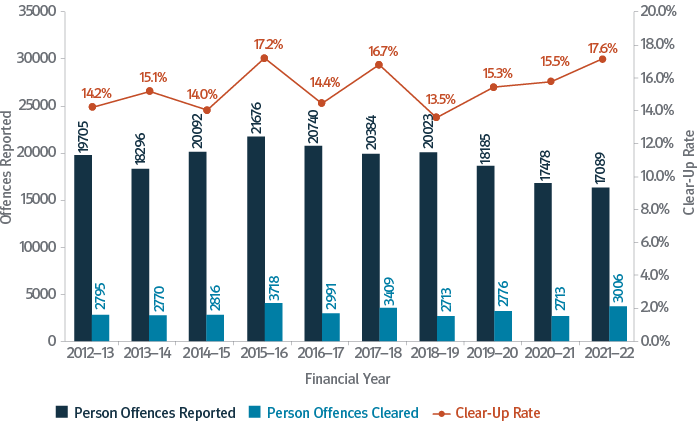
Source: PROMIS as at 4 July 2022
Performance Measure 5 – Percentage of briefs delivered to the Director of Public Prosecutions (DPP) within the designated timeframe
The target for this measure is to deliver 75 per cent or more briefs to the ACT Director of Public Prosecutions (DPP) within the designated timeframe. The designated timeframe commences from the date of the plea to the date disclosed by the DPP.
The designated timeframes are dependent on the matter and are subject to change by the DPP. Time frames are classified as follows:
- Adult matters: 42 days
- Family violence matters: 23 days
- Child matters: 30 days.
ACT Policing met the target for this measure, achieving a result of 83.3 per cent of briefs delivered to the DPP within the designated timeframe.
Performance Measure 6 – Percentage of cases finalised by offence proved in court
The target for this measure was 82 per cent or more cases to be finalised by the offence being proven in court. ACT Policing continues to perform well against this measure and achieved a result of 92 per cent.
Performance Measure 7 – Percentage of cases otherwise resolved
This measure relates to incidents where defendants are found unfit to plea due to mental illness. The target for this measure was to ensure 5 per cent or less of cases were otherwise resolved (other than by court, a not-guilty verdict or otherwise withdrawn). ACT Policing achieved the target recording 4.3 per cent of cases otherwise resolved.
Outcome: Public Safety
Police Response
Performance Measure 8 – Response times for Priority One incidents within 10 minutes
The target for Priority One (life threatening or critical) incidents is a response time of ten minutes or less for 80 per cent or more of incidents. ACT Policing did not achieve this target, responding to 76.6 per cent of Priority One incidents within 10 minutes.
FIGURE 4.9: RESPONSE TIMES FOR PRIORITY ONE INCIDENTS 2015–16 TO 2021–22
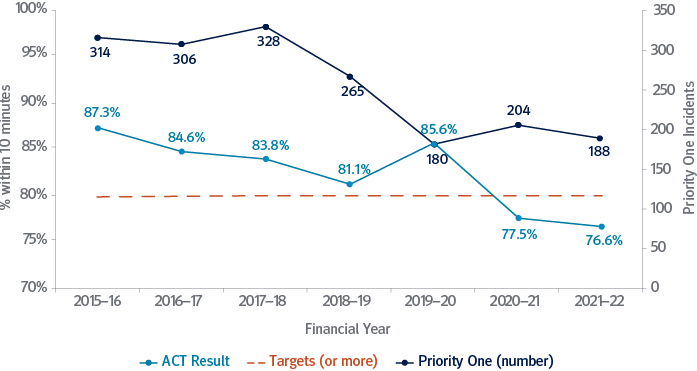
Source: PROMIS as at 4 July 2022
Performance Measure 9 – Response times for Priority Two incidents within 20 minutes
The target for Priority Two incidents is 80 per cent or more incidents responded to within twenty minutes. ACT Policing did not achieve the target, recording a result of 70.6 per cent.
Calls for Priority Two matters have increased 30 per cent in the last seven years which demonstrates an increased demand on ACT Policing. The continued expansion of Canberra suburbs has also contributed to ACT Policing failing to meet this measure by 9.4 per cent.
ACT Policing’s failure to meet the Priority Two target continues to be symptomatic of increased calls for service, placing additional pressure on police to respond to Priority Two matters within target time frames.
FIGURE 4.10: NUMBER OF PRIORITY TWO INCIDENTS 2015–16 TO 2021–22
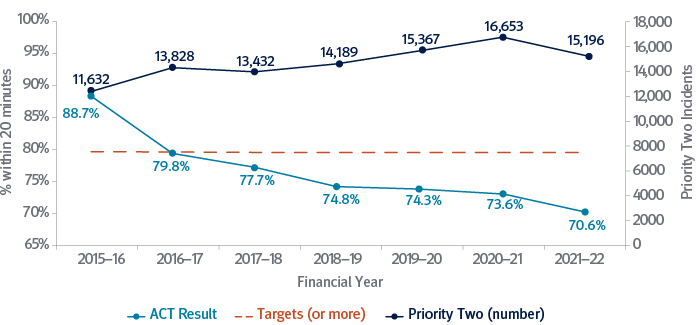
Source: PROMIS as at 4 July 2022
Performance Measure 10 – Response times for Priority Three incidents, no later than 48 hours from initial contact
The target for this measure was 90 per cent or more incidents where police attended or responded no later than 48 hours from the initial contact by the complainant, or within a time determined in consultation with the complainant. ACT Policing achieved the target, recording a result of 94.0 per cent.
ACT Policing apply the highest priority to the answering of Triple Zero calls and aim to answer them within ten seconds. Non-emergency calls to Triple Zero reduce ACT Policing’s capacity to respond to genuine emergency incidents in a timely manner. While ACT Policing continually remind the ACT Community not to call Triple Zero unless it is an emergency, nuisance or hoax phone calls, albeit low in volume, do exist and pose capacity issues. ACT Policing has also seen an escalation of calls to 131 444 which has in turn led to higher call wait times leading to some callers contacting Triple Zero instead.
Over the last five years the number of Triple Zero calls to Police Operations has increased over 15 per cent with the average number of monthly calls increasing from 2,439 per month to 3,145 per month. For 2021, the number of calls per month exceeded 3,000 for 10 of the 12 months.
Reduced resourcing due to COVID-19 isolation requirements has also contributed to capacity issues. ACT Policing conducted call taker training in December 2021 with eight participants graduating.
Performance Measure 11 a) – Percentage of Triple Zero (000) calls answered on first presentation
The target for this performance measure was 92 per cent of Triple Zero calls answered on first presentation. ACT Policing did not meet the target for this Performance Measure, recording a result of 88.7 per cent.
Performance Measure 11 b) – Percentage of Triple Zero (000) calls answered on second presentation
The target for this performance measure was 98 per cent of Triple Zero calls answered on second presentation. ACT Policing did not meet the target for this Performance Measure, recording a result of 96.4 per cent.
Public Order and Emergency Management
Performance Measure 12 – Percentage of the community satisfied with police in dealing with public order problems
During 2020–21, the Minister for Police and Emergency Services endorsed the removal of this Performance Measure, due to the removal of the question from the NSCSP.
Performance Measure 13 – Review and testing of arrangement for responding to and recovering from emergencies and disasters
COVID-19 impacted on the ability for ACT Policing to conduct face-to-face emergency testing arrangements and training, particularly in the first half of the financial year.The easing of health restrictions has allowed the reintroduction of in-person training and exercising.
Operation Vambrace is a series of drill style counter terrorism exercises with a focus on incident command and control. The exercises were run over a 12-week period so that every General Duties Team had exposure to the exercises. The operation was planned and commenced in the reporting period and will continue into the next period.
There has been a significant increase in protest activity during the reporting period. This begun in early November 2021 when climate change activists conducted disruptive protests in conjunction with 26th United Nations Climate Change Conference of Parties. Since December 2021, there has been an unprecedented volume of anti-COVID-19 restriction and freedom protests.
Debriefs have been conducted for this recent major protest activity and a post-operative assessment is in progress. There will be a number of recommendations to implement aimed at improving preparations for future large-scale demonstrations.
With the easing of COVID-19 health restrictions, organised mass gatherings have returned to almost pre-pandemic levels. The planning and preparation for the police response to these events have evolved to include COVID-safe and preventive measures should the events become targets of protest activity.
Case Study
COVID-19 Taskforce
Throughout the COVID-19 pandemic – both before, during and after Canberra’s 2021 lockdown – ACT Policing’s COVID-19 Taskforce worked 24 hours a day, seven days a week to ensure the safety of the Canberra community. Taskforce resources were bolstered during the lockdown to appropriately respond to the risk faced by the community by increased COVID-19 community transmission. This allowed the home, business and traffic checks to occur.
For ACT Policing, COVID was a sizeable challenge for all involved, from those on the front lines to those in support roles, required to rapidly adapt to the ever-changing environment. The COVID-19 Taskforce was responsible for coordinating ACT Policing’s response to COVID-19 and providing support to our officers for all COVID-related issues. The Taskforce acted as a point of contact, coordination and guidance, to advise members on changes to the health directions and new implementations of law.
At its height, approximately 110 members were attached to the Taskforce, including compliance teams, administrative support, embedded officers liaising with partner government agencies and a command structure. This command structure also expanded with the introduction of a dedicated COVID-19 Commander, to oversee ACT Policing’s COVID-19 response to the threat of the pandemic.
ACT Policing’s response was undertaken in accordance with the Public Health Act 1997 and the related Public Health Directions. At all times, the focus was to maintain an Engage, Educate, Enforce approach, in line with the ACT Government COVID-19 response. Arrests involving COVID-19 breaches were largely made in relation to a broader police response to more serious and related alleged offences including family violence, burglary and car thefts.
The Australian Defence Force (ADF) assisted ACT Policing between 22 September and 14 October 2021, to conduct COVID-19 border compliance checks. ADF personnel performed a supporting role focused on pre-screening vehicles. This interagency collaboration boosted the capability of cross-border operations and enabled a flexible and proactive response capacity for ACT Policing.
Between 12 August 2021 and 21 January 2022, ACT Policing performed 49,985 traffic compliance stops, 8,953 personal compliance checks, 3,004 business compliance checks and 623 directions to leave the ACT. During the same period, ACT Policing made 7 arrests for alleged breaches of health directions where no other offence had been involved, and 49 arrests for breaches of health directions attached to other offences. There were also 80 infringements and 135 cautions issued for alleged breach of health directions and 829 move-on directions. ACT Policing received 2,583 compliance complaints.
ACT Policing’s priority is always the safety and security of the community and our workforce, and this became increasingly important when the ACT recorded its first case of COVID-19 in March 2020. Our actions and response to COVID-19 helped to limit the spread of the virus in the community and reduce the impact on members and their families.
The pandemic has tested the resilience, professionalism and dedication of ACT Policing in new ways. COVID-19 completely changed the way we live, but ACT Policing is adaptive and rose to each challenge it faced and has at all times continued to keep the ACT community safe.
Road Safety and Traffic Management
Performance Measure 14 – Number of road crashes resulting in death per 100,000 population
The target for this performance measure was 4.2 or less road crashes resulting in death per 100,000 population. ACT Policing achieved the target, recording a result of 3.5 fatal road crashes per 100,000 population during 2021–22.
As presented in Figure 4.11 the number of fatal collisions per 100,000 population in the ACT remains consistently below the national average.
FIGURE 4.11: ROAD CRASHES RESULTING IN DEATH PER 100,000 POPULATION 2017–18 TO 2021–22
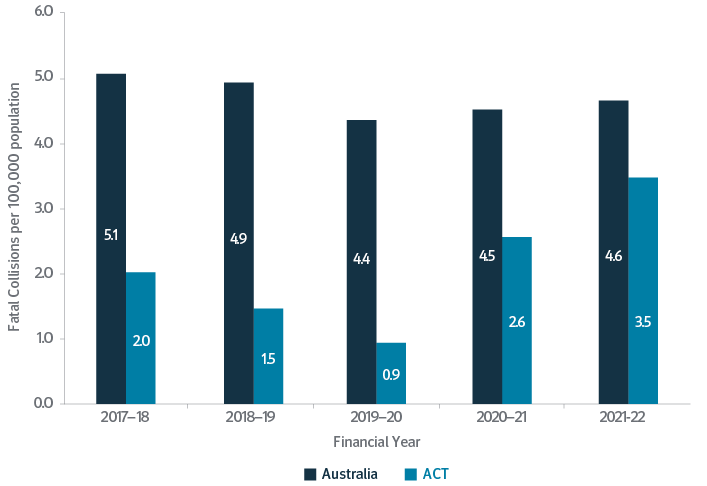
Source: Australian Road Deaths Database as at 30 June 2022
Performance Measure 15 – Number of road crashes resulting in injury per 100,000 population
The target for this measure was 180 or fewer road crashes resulting in injury per 100,000 population. ACT Policing achieved this measure with the number of road collisions resulting in injury recorded at 60.0 per 100,000 population
FIGURE 4.12: MOTOR VEHICLE COLLISIONS WITH INJURY 2017–18 TO 2021–22
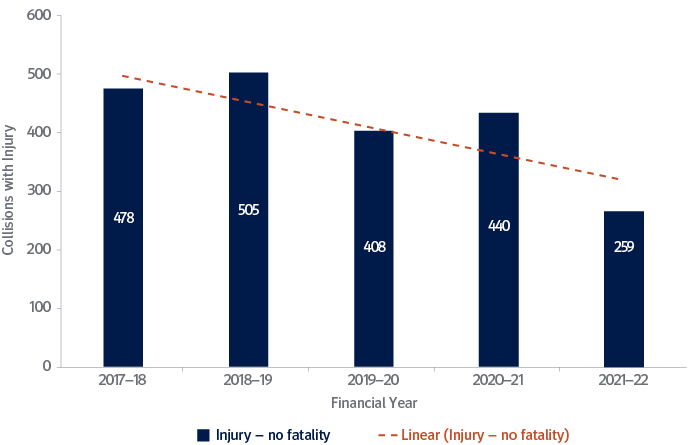
Source: PROMIS as at 4 July 2022
Case Study
Advanced technology helps piece together major collisions
ACT Policing have new tools and technology that are helping to improve scene reconstructions, yielding outstanding results for investigations of some of the ACT’s major collisions.
The new technology helps police officers of the Major Collision Team gather the information they need in half the time, and without needing to disrupt Canberra roads for hours.
Using a forensic imaging system, police can create a three-dimensional model of a crash scene in incredible detail.
Mounted on a tripod, the system makes a 360-degree scan of the scene, capturing hundreds of images and mapping millions of data points.
Police can do this without even stopping traffic, as the technology recognises extraneous information – such as passing vehicles – and will later remove it.
Investigators then analyse this digital reconstruction – examining factors like speed or road conditions – to assist in determining what caused the crash.
A Major Collision Team member advised that police arriving at the scene could immediately set up the scanner to actively begin scanning the scene at the same time as the walk through is happening, photos are being taken and evidence collected.
“We can produce a 30–40 page document explaining how a collision happened and, to go along with that, we can produce a 30-second video clip of what the collision looked like from any angle we want” the member said.
Returning to the scene of a 2019 crash to rescan it with the new system, he said the difference in time and detail was remarkable.
“Had we had this system when I was at the scene originally, instead of being there for five hours, we would have been there for about two-and-a-half,” he said.
This technology is a faster and more accurate way of gathering information to help with an investigation that will ultimately support the judicial process.
Case Study
Lachlan Seary fatal collision investigation
Nineteen-year-old Lachlan Seary was a beloved son, with a promising career in professional hockey who had just been selected to represent the ACT and play for the Canberra Braves.
After agreeing to be designated driver on a night out in the city with mates, Lachlan dropped his friends off safely, before he began the drive home to the south of Canberra.
On 8 March 2021, Lachlan’s moving vehicle was hit from behind on the Monaro Highway near Hume. A 28-year-old man who was driving his vehicle at approximately 163km/h in an 80 zone, struck Mr Seary’s vehicle and was later discovered to have had a prescribed drug in his system and a blood alcohol concentration of 0.185.
Investigations concluded that Mr Seary’s vehicle was hit with such force that his Toyota Corolla spun some distance clockwise, before it collided with the road barrier, entered a broadside slide, rolled over and hit a tree.
The 28-year-old offender’s vehicle spun to a stop where he was offered aid by a member of the public, and he indicated that he had hit a kangaroo. The witnesses realised the damage didn’t match the offender’s story and soon saw the headlights of Lachlan’s vehicle before trying to render aid.
ACT Policing Officers responded to the collision, and despite the best efforts of members of the public, ACT Fire & Rescue, ACT Ambulance Service and police, Mr Seary was tragically declared deceased at the scene.
Mr Gary Seary, Lachlan’s father, told the court that his life has been divided into two stages, before the accident, and after. He explained his grief is compounded every time he sees others suffering in the wake of road trauma.
After a 6-month investigation by ACT Policing’s Major Collision Team, on Friday 25 February 2022 the 28-year-old offender was sentenced by the ACT Supreme Court to 5 years’ imprisonment with a non-parole period of 2 years and 11 months. He was also disqualified from driving for 3 years.
Outcome: Community and Partner Engagement
Community Support and Whole-of-Government Engagement
Performance Measure 16 – Percentage of the community satisfied in general with services provided by police
The target for this measure is the national average or more as determined by the NSCSP. The national average for 2021–22 was 76.8 per cent, the ACT did not meet the target with a result of 76.3 per cent.
Performance Measure 17 – Percentage of the community who have confidence in police
The target for this measure is the national average or more as determined by the NSCSP. The national average for 2021–22 was 79.1 per cent, while the ACT result was 82.0 per cent.
Figure 4.13 shows ACT Policing’s performance against measures relating to community satisfaction and confidence.
FIGURE 4.13: SATISFACTION AND CONFIDENCE IN POLICE 2021–22
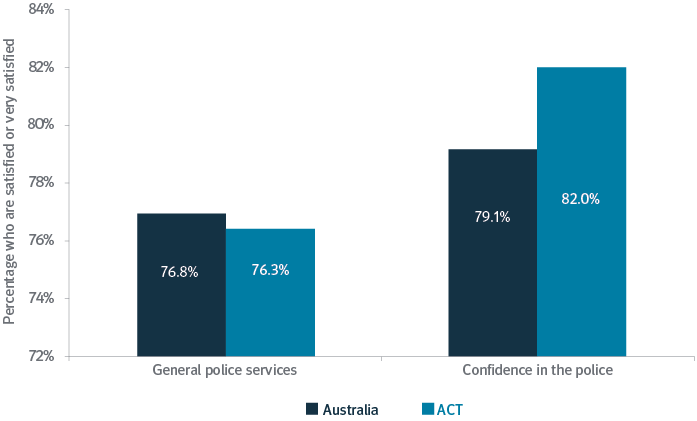
Source: National Survey of Community Satisfaction with Police, 4 July 2022
Case Study
Social media plays a vital role in operational successes
ACT Policing’s social media channels are a vital information-sharing tool, keeping the Canberra community informed and up to date. The content is meaningful and relatable, and it celebrates and supports the achievements and operations of police across all areas of the organisation.
During 2021–22 ACT Policing’s social media channels continued to contribute to many operational successes. These included witnesses coming forward with images and CCTV/dash-cam footage to assist major investigations, the location of missing persons, identification of persons of interest and vital updates being provided as part of regular investigations.
On 9 July 2021, ACT Policing arrested a 28-year-old man and two women involved in an escape from ACT Corrective Services. Multiple social media posts were issued in relation to the response to this incident including a livestream of the press conference at the scene. Information provided by the public indicated the man was hiding in a house in Lyneham. This resulted in the deployment of specialist negotiators to facilitate the safe surrender of the man. The Facebook post reached more than 68,000 people.
On 14 January 2022, a social media post with CCTV stills of a man was published seeking the public’s assistance in identifying a person of interest allegedly involved in an assault at Exhibition Park in Canberra during Summernats. An 18-year-old man was punched in the face and required surgery as a result of the assault. The person of interest was identified and subsequently extradited from NSW on 13 April 2022. The Facebook post reached more than 128,000 people.
On 15 March 2022, CCTV images were released to the public seeking to identify two men following an assault on 20 February 2022 in Verity Lane, Canberra City where a man sustained a severe head injury and was unconscious. Within seven hours of posting to ACT Policing’s social media channels, the men handed themselves in to Belconnen Police Station. The Facebook post reached more than 40,000 people.
On 29 March 2022, a social media video was published seeking the public’s assistance to identify a man allegedly involved in an assault on 10 February 2022 at Exhibition Park in Canberra where a 67-year-old woman sustained fractures to both her wrists, requiring surgery. The Facebook post reached more than 57,000 people. Following the receipt of public information and with the assistance of NSW Police, on 3 May 2022, a search warrant was executed at an address in Kings Langley, NSW. A 34-year-old man was arrested, with police alleging the man was in Canberra at the time of the incident as part of ongoing protest activity. He was charged with recklessly inflicting grievous bodily harm and trespassing.
On 4 June 2022, public assistance was sought to identify two women who were believed to have information regarding an alleged assault at Mooseheads in Canberra City on 15 May 2022. Both women contacted police within one hour of the post being published to social media confirming they were the persons of interest and investigations are ongoing. The Facebook post reached more than 29,000 people.
Sixty missing persons and two wanted persons were located from 1 July 2021 to 30 June 2022 after their images were posted to ACT Policing’s social media platforms.
With more than 227,000 followers collectively across ACT Policing’s Facebook, Instagram and Twitter accounts, social media continues to be an important tool in directly engaging with the Canberra community, supporting operational outcomes, increasing community trust and confidence in policing and profiling various areas and people in ACT Policing.
Case Study
Project Safe Plate
More than 690 vehicle number plates were fitted with tamper-proof screws when ACT Policing partnered with Neighbourhood Watch to deliver two Project Safe Plate events for the Canberra community.
Following a marked increase in number plate theft across the ACT, the initiative was reinstated to target this crime type and deter thieves.
During the 2021–22 financial year, 1,368 number plates were reported stolen to ACT Policing, an increase of 175 from the previous year. Stolen number plates can be used across the ACT and interstate to commit secondary offences. Stolen number plates are placed on stolen vehicles to avoid police detection and are also used to disguise the real identity of a vehicle when it is used in other crimes such as petrol drive-offs and burglaries.
Plates are sometimes taken from a similar make and model of vehicle and placed on a car that is out of registration. This makes it harder for police and other agencies to determine if a vehicle is registered.
The Project Safe Plate crime prevention initiative involved police officers, police recruits, members from the Public Engagement Team and Volunteers in Policing and were joined by Neighbourhood Watch. Vehicles were fitted with free tamper-proof screws at a temporary drive through facility at Tuggeranong Police Station on 11 December 2021 and at the Kingsford Smith School in Holt on 9 April 2022.
The events were huge successes with 242 vehicles attending the southside event and 452 vehicles attending in the north, almost doubling the number at the previous event. Attendees came from far and wide – with community members driving from across Canberra, Queanbeyan and Murrumbateman specifically for the event.
While cars were the majority of vehicles fitted, motorcycles, trucks, trailers and even a caravan were also brought along.
Police received overwhelmingly positive feedback from attendees, with the average fitting time no longer than five minutes from entering the event to driving away with new screws. Several attendees were so impressed with the service, they returned with another vehicle to be fitted.
Following the success of the initiatives, Project Safe Plate is planned to continue its rollout across Canberra zones in 2022–23.
Case Study
Constable Kenny Koala
The Constable Kenny Koala program has been delivering safety presentations to Canberra children for more than 46 years, and despite COVID-19 restrictions impacting face-to-face delivery in schools, Constable Kenny was still able to reach more than 20,900 students during 2021–22.
The lovable koala is an icon across Canberra especially in early childhood settings, preschools and primary schools. He has an important role to play in teaching children aged 3 to 12 years-old how to Stay OK and build positive perceptions of police.
Despite not being able to visit schools in person during parts of the year, Constable Kenny’s program turned to online learning, offering schools a virtual presentation to ensure his vital safety messages could continue.
Students were treated to interactive virtual presentations on road safety, cyber safety, protective behaviours and decision making. By all accounts, the children thoroughly enjoyed seeing Constable Kenny on their screens at school.
In 2021–22 the Constable Kenny program:
- delivered 890 classroom presentations
- visited 407 schools
- had 21,018 hits on his website
- attended five community events.
When he was able to, Constable Kenny got out and about in the Canberra community attending local events such as the Royal Canberra Show, Reconciliation Day and Africa Party in the Park, putting lots of smiles on children’s and adult faces alike.
Constable Kenny was able to make the trip to Jervis Bay in April 2022. As part of the ACT, the program covers the Bay and it is one of Constable Kenny’s favourite days, travelling down to visit the local school and children. The rain didn’t dampen the children’s spirits and they were very excited for his visit. The children asked lots of questions during his presentations, which taught them valuable safety lessons. They even braved the rain to see the flashing lights on the Constable Kenny Koala car.
Performance Measure 18 – Percentage of eligible young people referred to restorative justice
The target for this performance measure is for ACT Policing to refer 100 per cent of eligible young offenders to restorative justice.
Results for 2021–22 show ACT Policing did not meet the target for this performance measure, with 61 per cent of eligible young offenders referred to restorative justice. During the reference period, 45 offenders were not referred to restorative justice (a 39.1 per cent variation in target).
ACT Policing recognises the role of restorative justice (RJ) in the ACT Government Reducing Recidivism by 25 per cent by 2025 policy (RR25by25), and fully appreciates the role of police in contributing to that aspiration. In late 2020 ACT Policing embarked on a program to improve RJ referral rates of all offenders, but particularly young offenders. This body of work is evolving and includes:
- reinvigoration of the relationship with the Justice and Community Safety Directorate RJ Unit (RJU)
- convening roundtable discussions with the RJU and RJ stakeholders/partners including the ACT DPP, ACT Court, SupportLink, the Aboriginal Legal Service and ACT Legal Aid
- workforce engagement to understand impediments to RJ
- reform of the RJ role within ACT Policing – moving from transactional workflow to one of policy and practices improvement, workforce communications and RJ reform.
Much of this work has been affected by the COVID-19 pandemic, however, stakeholders and partner agencies are now moving ahead. Consequently ACT Policing is undertaking broad engagement and dialogue to identify reforms. These reforms will need to be achieved within the limitations of the Crimes (Restorative Justice) Act 2004. They will also consider the appropriateness of reform to the Act to amend offender eligibility criteria, particularly concerning young offenders and to align RJ referral capability with that of the Courts.
In February 2022, ACT Policing’s Early Diversion Team (EDT) implemented a revised SupportLink template and adopted case management of referrals made to the ACT Restorative Justice Unit (RJU). Due to the previous platform being unstable and the referral form being long and repetitive, the number of referrals to the RJU has been suboptimal. In 2021, the EDT worked collaboratively with ACT members and the RJU to improve the SupportLink template and by utilising the feedback provided, have created a template and process that is more streamlined and reduces administration pressure for front line members. As part of the upgrade, the EDT adopted case management and directly provided the RJU information that was previously included in the SupportLink template by members, significantly easing the pressures of administrative duties for police.
Performance Measure 19 – Number of persons referred to community support agencies
The target for this measure is 5,500 or more persons referred to community support agencies.
Results for 2021–22 show ACT Policing met this target with 5,567 referrals to SupportLink, which is 1.2 per cent above the target.
ACT Policing will continue to refer people to appropriate support agencies as alternate avenues to formal court processes.
Case Study
Restorative Justice
ACT Policing believes providing support to victims of crimes can be done in more ways than solely through the court process.
The concept of restorative justice (RJ) enables offenders to acknowledge the harm they have caused by facing their victim and hearing firsthand the damage their actions have caused, in a carefully managed and safe environment.
The conversation (whether in person or not) can include discussion about the details of the crime and the next steps to seek a resolution for all parties involved. Generally it is the victim and offender who take part, but others affected, including friends or family, can also be involved.
In the ACT, RJ conferences are facilitated by the Restorative Justice Unit (RJU) of the Justice and Community Safety Directorate. ACT Policing funds a position within the RJU to be the liaison point for RJ referrals.
Putting a human face, pain and emotion behind the crime, of not only the victim, but those close to the offender, works as an important diversion tool. This is something that the court process does not always achieve. If successful, RJ also lessens the workload involved with progressing a matter to be heard before court.
The gratitude expressed to ACT Policing from a parent of an assault victim who had been attacked in 2021, is just one example of the positive effects RJ can have.
Once ACT Policing case officers had gathered sufficient evidence, the option of RJ was raised with the victims, and their parents agreed to a RJ facilitated conference with the perpetrator, on 18 February 2022.
Following the conference, the facilitator consulted the parents to gauge their opinions on the meeting and whether it would be necessary to progress the matter to court. RJ can be used instead of the court process, or it can run in conjunction. Both victims’ parents were satisfied with the outcome of the conference and declined to take the matter to court.
On 18 March 2022, one of the victims’ fathers wrote to the Minister for Police and Emergency Services advising that despite initial hesitations about the process, he was very impressed by the professionalism of police, and the efficiency with which the offender was identified. The father was also grateful for the constant communication he received from police in providing updates during the investigation process. The team at the diversionary justice team were also thanked for being very effective and consultative during the process.
Performance Measure 20 – Number of referrals to drug diversion programs (drug demand reduction effort)
The target for this measure was 80 or more referrals to drug diversion programs.
Results for 2021–22 show ACT Policing met this target with 112 people diverted into the Early Intervention and Drug Diversion Programs.
ACT Policing continues to focus on drug harm minimisation through these referrals. Given the majority of these persons would have otherwise entered a formal court process, this reduces the overall burden on the justice system and seeks to minimise the harm caused by illicit drugs.
Performance Measure 21 – ACT Policing Victim Liaison Officers providing contact with victims of indictable crime reported to police
The target for this measure was 80 per cent or more.
ACT Policing achieved this target, with 80 per cent of victim survivors contacted by our Victim Liaison Officers (VLOs) during 2021–22.
Providing assistance to victim survivors of crime through VLO contact has the potential to reduce further victimisation, stop the escalation of crime and provide victim survivors with appropriate support.
Other Reporting
Recommendation 10 of the Report on the Inquiry in the Form of an Evaluation of Current ACT Policing Arrangements states that ACT Policing will report on its use of interpreters and translators in its Annual Report from 2020–21.
TABLE 4.3: NUMBER OF REQUESTS ACT POLICING RECEIVED FOR INTERPRETERS AND TRANSLATORS
| Month | 2020–21 | 2021–22 |
|---|---|---|
| Jul | 23 | 21 |
| Aug | 16 | 11 |
| Sep | 18 | 11 |
| Oct | 21 | 13 |
| Nov | 16 | 18 |
| Dec | 9 | 18 |
| Jan | 15 | 19 |
| Feb | 10 | 13 |
| Mar | 23 | 15 |
| Apr | 17 | 10 |
| May | 24 | 21 |
| June | 16 | 10 |
| TOTAL | 208 | 180 |
Source: National Operations State Service Centre Interpreter and Translator Team, 1 July 2022
Case Study
60 Years of Rural Patrol
ACT Rural Patrol was established in 1962, when radio reception was poor in the remote areas of the ACT and the designated patrol vehicle was a two-wheel-drive Volkswagen Beetle. Rural Patrol has come a long way since then, ith today’s Land Cruiser fitted with essential safety and high-tech operational equipment. In 2022, ACT Policing marked the 60th anniversary of Rural Patrol.
While Canberra’s rural environment has changed over the past 60 years, the Rural Patrol team’s fundamental objectives have not, with expert knowledge of the rural areas and relationship building with partner agencies, locals and landholders still vital to the role. The team’s collaborative approach, fostered through regular attendance at community meetings and conducting open forums, has proven beneficial time and time again, contributing to many operational successes.
In 2017 Rural Patrol conducted an operation with ACT and NSW Parks partner agencies in response to the misuse of firearms within national parks, resulting in two arrests and 16 firearms and prohibited weapons charges.
Rural Patrol also regularly works in close collaboration with NSW Police Force (NSWPF). Between 2017 and 2021, Rural Patrol used local contacts to identify and investigate over 15 cannabis grow sites, with five offenders identified. The team also engaged its established network to identify five people responsible for a spate of rural burglaries in 2020 and used this intelligence to establish a joint operation with Criminal Investigations and NSWPF Rural Crime Investigations. The joint operation resulted in the execution of five search warrants in ACT and NSW, and offender apprehensions for 19 charges.
Their training provides the skills necessary for members to operationally meet a number of requirements including rural aerial surveillance, 4WD skills, and specialist weapons training to assist euthanising injured animals. ACT Policing are also looking towards the future and have established a part-time Rural Patrol capability to capture the skills and knowledge of former members and up-skill existing General Duties members.
The team are a vital part of ACT Policing’s capabilities and the expertise Rural Patrol members develop during their time with the team goes on to benefit the whole of ACT Policing.
It has been a busy 60 years for Rural Patrol.
5 Professional Standards
The term professional standards relates to the Commissioner’s expectation that all AFP appointees, including those in ACT Policing, will serve with integrity.
AFP Professional Standards, which sits within the AFP’s Office of Deputy Commissioner Operations, is responsible for developing and maintaining the highest professional standards throughout the organisation, as well as overseeing and investigating complaints about the conduct of AFP appointees.
The AFP’s professional standards are underpinned by the AFP Core Values (see Chapter 3: Our Values) and the AFP Code of Conduct. Further information on the AFP Values and the AFP Code of Conduct is available on the AFP website.
AFP Professional Standards Framework
The AFP’s professional standards framework is governed by Part V of the Australian Federal Police Act 1979 and the Australian Federal Police Regulations 1979.
This framework is further supported by internal governance such as the Commissioner’s Order on Professional Standards and the National Guideline on Complaint Management. The Commonwealth Ombudsman and the Australian Commission for Law Enforcement Integrity (ACLEI) oversee the framework.
The AFP is committed to managing fraud and corruption risks as part of its everyday business, and complies with the Australian National Audit Office Better Practice Guide on Fraud Control in Australian Government Entities. As a Commonwealth entity, the AFP has a Fraud Control and Anti-Corruption Plan, which ensures compliance with the Public Governance, Performance and Accountability Rule 2014 (Cth).
The ACT community has the reassurance of regulation 18 of the Law Enforcement Integrity Commissioner Regulations 2017, which establishes a mechanism for the relevant ACT Government Minister to be informed about ACLEI’s activities when investigating serious corruption and systemic corruption as defined by the Law Enforcement Integrity Commissioner Act 2006.
The AFP’s professional standards model adopts a tiered approach according to the seriousness of the breach:
- Category 1 conduct — relating to customer service matters, managed in the workplace
- Category 2 conduct — relating to minor misconduct, managed in the workplace
- Category 3 conduct — relating to serious misconduct including breaches of the criminal law or serious neglect of duty, investigated by Professional Standards
- Corruption issues (also referred to as Category 4).
Complaints dealing with Categories 1 and 2 of the AFP’s professional standards are managed by line managers through the ACT Policing Complaint Management Team.
More serious matters that may result in employment suitability consideration (Category 3) are investigated by the AFP’s Professional Standards area. Every Category 3 matter is further reported to the Commonwealth Ombudsman for additional oversight.
Complaints and information about corrupt conduct of AFP appointees are referred to ACLEI. Pursuant to section 26 of the Law Enforcement Integrity Commissioner Act 2006, the Integrity Commissioner will determine whether a matter is investigated solely by ACLEI, jointly with AFP Professional Standards, or as an AFP-only investigation (with or without ACLEI oversight or management).
Corruption conduct includes bribery and misuse of public office such as payment or receipt of secret commissions, release of confidential information in exchange for a benefit, serious conflict of interest or serious nepotism and/or cronyism. The term ‘benefit’ is not restricted to a material benefit. A benefit may be tangible or intangible and may include information. A beneficiary may receive an indirect benefit and/or be a third party.
ACT Policing Complaint Statistics Financial Year 2021–22
Complaint Data
All data related to complaints was extracted from the AFP’s SAS Visual Analytics suite, which is a live system, updated on a daily basis. This report is reflective of Category 1–4 complaints that relate to members of ACT Policing. The data for this report was extracted and accurate as at 1 July 2022. This data is subject to change as complaints are upgraded, downgraded, merged, allocated and re-opened.
During the financial year 2021–22, AFP’s Professional Standards received 71 complaints relating to ACT Policing, resulting in 127 alleged conduct breaches5 being recorded.
TABLE 5.1: ALLEGED COMPLAINTS RECORDED DURING 2021–22, BY SOURCE
| Source | Total complaints | Percentage |
|---|---|---|
| Member of the public | 38 | 53.52% |
| Reporting another AFP member | 33 | 46.48% |
| Total | 71 | 100.00% |
TABLE 5.2: ALLEGED CONDUCT BREACHES RECORDED DURING LAST FOUR YEARS, BY CATEGORY6
| All ACT Policing breaches | 2018-19 | 2019-20 | 2020-21 | 2021-22 |
|---|---|---|---|---|
| Category 1 | 82 | 68 | 34 | 44 |
| Category 2 | 69 | 42 | 50 | 39 |
| Category 3 | 49 | 47 | 47 | 30 |
| Corruption issues | 16 | 11 | 16 | 14 |
| Total | 216 | 168 | 147 | 127 |
Non-compliance with Body Worn Camera Governance
As at 1 July 2022, for the 2021–22 year no complaints regarding the use of, or failure to use, a Body Worn Camera by any ACT Policing member were received by Professional Standards. Further to this, no complaints were received involving the non-compliance or governance breaches against mandatory Body Worn Camera use, based on the requirements under the Crime (Surveillance Devices) Act 2010 (ACT) or the 2022 Crimes (Surveillance Devices) Body-worn Cameras Guidelines Disallowable Instrument.
TABLE 5.3: FINALISED CONDUCT BREACHES7 DURING 2021–22, BY CATEGORY8
| All ACT Policing breaches | Established | Not established | Discretion not to proceed9 | Withdrawn |
|---|---|---|---|---|
| Category 1 | 4 | 32 | 4 | 0 |
| Category 2 | 25 | 29 | 5 | 0 |
| Category 3 | 9 | 43 | 9 | 1 |
| Corruption issues | 0 | 15 | 5 | 0 |
| Total | 38 | 119 | 23 | 1 |
TABLE 5.4: FINALISED ESTABLISHED CONDUCT BREACHES DURING 2021–22
| Conduct breach | Number established |
|---|---|
| Inappropriate Behaviour/Conduct | 7 |
| Due Care/Diligence Failure | 4 |
| Not Specified10 | 4 |
| CO311 non-Serious Nature | 2 |
| Drug Misconduct | 2 |
| Failure to Act | 2 |
| Inappropriate Behaviour/Conduct Serious | 2 |
| Information Access | 2 |
| CO311 Fail Secure Ammunition/Accoutrements | 1 |
| CO311 with Injury | 1 |
| Conflict of Interest | 1 |
| Discourtesy | 1 |
| Driving Misconduct | 1 |
| Fail to Comply with Direction | 1 |
| Harassment | 1 |
| Information Misuse | 1 |
| Information Release | 1 |
| Prescribed Concentration of Alcohol | 1 |
| Property Holding Failure | 1 |
| Property Misconduct | 1 |
| Unreasonable Delay | 1 |
| Total | 38 |
Timeliness of Complaints
Timeliness benchmarks are applied to Category 1–3 complaints. The benchmarks are: 42 days for Category 1 matters (if not informally resolved within five business days),66 days for Category 2 matters, and 256 days for Category 3 matters. Corruption issues fall under the Law Enforcement Integrity Commissioner Act 2006 (Cth) and are not subject to a timeliness benchmark.
TABLE 5.5: AVERAGE AND MEDIAN12 RUN TIME OF FINALISED COMPLAINTS 2021–2213
| Finalised ACT Policing complaints | Number of complaints | Average run time (days) | Median run time (days) | % within benchmark | % exceeding benchmark |
|---|---|---|---|---|---|
| Category 1 | 27 | 43 | 40 | 63% | 37% |
| Category 214 | 28 | 303 | 93 | 35.7% | 64.3% |
| Category 3 | 29 | 261 | 220 | 55.2% | 44.8% |
| Corruption issues | 14 | 444 | 359 | Not applicable | Not applicable |
| Total | 98 | 23915 | 10916 | - | - |
TABLE 5.6: COMPLAINTS ON HAND17, AS AT 1 JULY 2022
| All ongoing ACT Policing complaints | Ongoing complaints | Within benchmark | Exceeding benchmark | 1–30 days over | 31–89 days over | 90 days or more over |
|---|---|---|---|---|---|---|
| Category 1 | 4 | 2 | 2 | 1 | 1 | 0 |
| Category 2 | 9 | 6 | 3 | 0 | 1 | 2 |
| Category 3 | 15 | 10 | 5 | 0 | 1 | 4 |
| Corruption issues | 15 | Not applicable | Not applicable | Not applicable | Not applicable | Not applicable |
| Total | 43 | 1818 | 1016 | 1 | 3 | 6 |
TABLE 5.7: NUMBER OF INFORMAL COMPLAINTS REPORTED TO THE ACT COMPLAINTS MANAGEMENT TEAM (CMT) 2021–22
| All ACT CMT complaints | |
|---|---|
| Informal complaints reported to the ACT CMT in 2021–22 | 139 |
TABLE 5.8: NUMBER OF VICTIMS’ RIGHTS RELATED COMPLAINTS REPORTED 2021–22
| Victims’ rights-related complaints | ||
|---|---|---|
| Statement of how many complaints were made to the agency within the year | 28 | |
| For each written complaint, the right in relation to which the complaint was made19 | 14C Respectful engagement with victims | 23 |
| 14D Respectful engagement with child victims | 4 | |
| 14E Contact with victims | 12 | |
| 14F Victims’ privacy | 1 | |
| 15(1) Referral of victims to support services | 5 | |
| 15A Provision of aids or adjustments to victims | 1 | |
| 15D/18C Tell victims about administration of justice processes | 3 | |
| 15F Tell victims about victim impact statement | 1 | |
| 18D/18E Victims may make victims’ rights complaints and justice agencies must deal with them | 1 | |
| 16A Update victims about status of investigations | 12 | |
| For each written complaint, whether the agency resolved the complaint | 22 | |
Trends Analysis
Alleged Complaints and Conduct Breaches Submitted
Compared to 2020–21, ACT Policing has seen a 14.46 per cent decrease in the total number of complaints Professional Standards received relating to ACT Policing members (83 to 71) during the 2021–22 year. The source of the complaints received in 2021–22 from a Member of the Public (38) remained relatively consistent when compared with the 2020–21 year (39). The number of complaints made by another AFP member decreased by 23.3 per cent during the 2021–22 year compared to the 2020–21 year (43 to 33). There were no self-reported complaints relating to members of ACT Policing during the 2021–22 year.
Compared to 2020–21, ACT Policing have seen a 13.6 per cent decrease in total alleged conduct breaches (147 to 127) during 2021–22, and a 41.2 per cent decrease since the 2018–19 year (216 to 127).
Category 1 — ACT Policing have seen an increase of 29.4 per cent in alleged Category 1 breaches compared to the previous year (34 to 44). The alleged Category 1 breaches submitted in the 2021–22 year are 46.3 per cent lower than the alleged Category 1 breaches submitted in the 2018–19 year (82 to 44).
Category 2 — Compared to the 2020–21 year, there was a decrease of 22 per cent in the number of alleged Category 2 breaches submitted (50 to 39). The alleged Category 2 breaches submitted in the 2021–22 year are 43.5 per cent lower than the alleged Category 2 breaches submitted in the 2018–19 year (69 to 39). Of the last four years, the 2021–22 year had the lowest number of all Category 2 breaches submitted.
Category 3 — Compared to the 2020–21 year, ACT Policing have seen a 36.2 per cent decrease in the number of alleged Category 3 breaches submitted (47 to 30). The alleged Category 3 breaches submitted in the 2021–22 year are 38.8 per cent lower than those submitted in the 2018–19 year (49 to 30). Over the last four years, the number of alleged Category 3 breaches submitted has gradually declined (49, 47, 47, 30).
Corruption Issues — ACT Policing have seen a decrease of 12.5 per cent in alleged corruption issues submitted compared to 2020–21 year (16 to 14). Overall the number of alleged corruption issues submitted across the last four years has remained relatively consistent (16, 11, 16 and 14 respectively).
The topmost alleged breaches submitted against ACT Policing members were:
Category 1
- Discourtesy
- Failure to Act
- Inadequate Service
Category 2
- Due Care/Diligence Failure
- CO311 Non-serious Nature
- Fail to Comply with Procedure
Category 3
- Information Access
- Neglect of Duty
- Criminal Misconduct
Finalised complaints and conduct breaches
In 2021–22, 98 complaints (181 conduct breaches) were finalised. This is an increase of two complaints and a decrease of six breaches finalised compared to the 2020–21 year.
The percentage of finalised complaints within the defined benchmarks for Category 1–3 complaints was 51 per cent (43 of the 84 complaints). The remaining 14 finalised corruption issues fall under the Law Enforcement Integrity Commissioner Act 2006 (Cth) and are not subject to a timeliness benchmark.
In the 2021–22 year, finalised Category 1–4 conduct breaches resulted in the following conduct breach findings:
- 21.2 per cent (38) Established
- 66.5 per cent (119) Not Established
- 12.8 per cent (23) Discretion Not to Proceed
- 0.6 per cent (1) Withdrawn.
The percentage of Established Category 1–4 conduct breaches finalised in 2021–22 increased 52 per cent compared to the 2020–21 year (25 to 38). While the percentage of Not Established Category 1–4 conduct breaches finalised during the same period decreased by 11.2 per cent (134 to 119). The overall number of conduct breaches that were finalised within the same year, and had a finding of Discretion Not to Proceed or Withdrawn, stayed relatively consistent with the previous year.
To maintain proper oversight and ensure AFP complaint investigations maintain integrity and fairness in practice and process, the Commonwealth Law Enforcement Ombudsman undertakes a review of randomly selected complaint investigations every year. ACT Policing and the AFP work closely with the Commonwealth Law Enforcement Ombudsman to adopt the principles of best practice for complaint management.
Established matters
The number of established conduct breaches has fluctuated across the last four financial years (range of 25 to 43). In 2018–19 and 2019–20 established Category 2 conduct breaches represented the highest portion of established breaches for each year (46.51 per cent and 55.81 per cent respectively), while in 2020–21 Category 2 and Category 3 conduct breaches both represented 36 per cent of established breaches each, the highest portions of established conduct breaches by category for that year. Of the 38 established breaches in 2021–22, 25 of those were Category 2 conduct breaches, which represent 65.79 per cent of all established Category 1–4 conduct breaches. Whilst the percentage of Category 2 established breaches is notably higher in 2021–22 than previous years, it is consistent with Category 2 established conduct issues being the highest portion, or equal to the highest portion of established breach conduct categories across the last four financial years.
In the 2021–22 year, 44.64 per cent of the finalised Category 2 conduct breaches had a finding of established, compared to 34.78 per cent in the previous year. In the 2021–22 year, 14.52 per cent of finalised Category 3 conduct breaches had a finding of established, compared to 18.91 per cent in the previous year. In the 2021–22 year, there were 75 per cent (15) not established and, 25 per cent (5) Discretion Not to Proceed9 corruption issues; and positively, there were no established corruption issues.
The most prevalent established conduct breached in the 2021–22 financial year was Inappropriate Behaviour/Conduct (7). This is an increase of two from the five recorded in 2020–21 (5 to 7).
As outlined in the Statement of Intent dated 18 December 2020,20 Commissioner Kershaw set a target of Category 1–4 established Professional Standards breaches to be less than 3.1 per 100 staff members. ACT Policing are not within this target, resulting in 4.0621 established Category 1–4 conduct breaches per 100 staff members.22 The breakdown of established Category 1 and 2 conduct breaches per 100 staff is 3.09,20 and the breakdown of established Category 3 conduct breaches per 100 staff is 0.96.20
6 Use of Force
All AFP members including those in ACT Policing are governed by AFP Commissioner’s Order 3 (CO3) in the application of use of force principles. CO3 articulates mandatory compliance requirements in reporting and training.
All police members receive use of force training, during which the principles of communication and conflict de-escalation are emphasised as alternatives to the use of physical force. Police members are required to complete these use of force qualifications annually.
In all cases where members use force that is not a routine use of force the officer must, as soon as practical, submit a use of force report. ‘Use’ is defined with respect to the type of force used, which is as follows:
- Firearm, conducted electrical weapon (CEW) or chemical agent (OC Spray) or extended range impact weapon:
- drawing
- aiming
- discharging
- Baton:
- raising with the intention to strike or gain compliance
- striking a person
- Shield:
- striking a person with any part of the shield
- Police dog:
- directed intentional deployment at a person with the intention to gain compliance whether or not the police dog bites the subject
- defence of itself, handler or any other person
- Pyrotechnic device:
- discharging the device so that concussive force, light, sound or any combination of these is emitted against another person23
- Long range audio device:
- Emitting sound from the device against another person to gain subject control.23
Routine use of force means the following uses of force performed as part of an AFP appointee’s operational duties:
- compliant escort or restraint holds (including to effect an arrest)
- compliant handcuffing
- compliant search of a person
- force to enter a building, vehicle, vessel, or other secured area to search, recover, seize or arrest, where there is no application of force against a person.
Spithoods are a restraint used to prevent a person in custody from spitting at or biting officers.
Routine uses of force or verbal commands which do not involve the application of use of force options are not reportable. The circumstances of each routine use of force incident event must be recorded within the relevant PROMIS case.
All use of force reports are assessed for compliance with CO3 by the officer’s supervisor. When reviewing the report the supervisor must identify, address and report to Professional Standards (PRS) any suspected misconduct issues arising from the reportable use of force incident. In addition, the Ombudsman can, and does, enquire as to use of force incidents and is empowered to make recommendations for the ongoing transparency of use of force recording and reporting processes.
The principles of negotiation, communication and de-escalation are always emphasised as being primary considerations prior to using physical force. Governance and oversight arrangements are in place to assure the community that any use of force is applied appropriately.
Table 6.1 summarises the number of use of force reports submitted by ACT Policing. During the 2021–22 reporting year, the number of use of force reports submitted by ACT Policing increased 14.6 per cent when compared to the previous year.
TABLE 6.1: USE OF FORCE REPORTS SUBMITTED BY ACT POLICING
| 2020–2124 | 2021–22 | Percentage Change (%) | |
|---|---|---|---|
| Baton | 22 | 36 | 63.6% |
| Chemical Agent | 90 | 154 | 71.1% |
| Conducted Electrical Weapons | 329 | 344 | 4.6% |
| Firearm | 31 | 49 | 58.1% |
| Handcuffs | 621 | 670 | 7.9% |
| Total | 1,093 | 1,253 | 14.6% |
7 Staffing Profile
Recognising the unique stressors and threats associated with policing as a profession, the health and wellbeing of members continues to be a strong focus for ACT Policing. Funded by the AFP, over the 2021–22 financial year the AFP Police Health Model known as SHIELD has been implemented within ACT Policing. SHIELD is a new way of delivering health and wellbeing services to members with a strong focus on education, prevention and early intervention.
The commencement of SHIELD services in ACT Policing has seen the addition of new clinicians to support ACT Policing members, including a registered nurse, Physiotherapist, Health and Fitness Advisor, Social Worker and the services of a Medical Officer.
These clinicians enhance support services that are already available to ACT Policing members, including dedicated injury prevention and management specialists. There are also three dedicated Welfare Officers and two dedicated psychologists to provide both proactive and responsive support and services. This includes support after critical incidents, assistance with workplace or personal matters, and as an initial point for the provision of further support. Support is available 24/7 via on-call arrangements.
ACT Policing reports on members by headcount and Full-time Equivalent (FTE). Headcount is the number of ACT Policing members as at 30 June 2022. FTE figures are reported as an average over the full financial year and exclude members who are classified ‘inoperative unpaid’ (members who are on leave and not being paid by ACT Policing)25. The reporting of average FTE provides the most accurate reporting of resourcing across the year.
In line with the Purchase Agreement, ACT Policing’s FTE is supplemented by the enabling services of the AFP. In 2021–22, 203 nominal FTE were purchased to support ACT Policing under the enabling services model. This notional FTE of sworn and professional members represents the services provided by the broader AFP in the delivery of community policing services to the ACT. Examples of such services include the Specialist Response Group, Forensics and Professional Standards. Reported FTE figures are higher than the reported headcount due to the inclusion of these enabling FTE.
The enabling FTE of 203 excludes ACT Policing members conducting Commonwealth-funded duties and SHIELD services, as these are not reflected in any of the reported headcount figures.
As at 30 June 2022, there were a total of 937 members within ACT Policing, of which 4.38 per cent identify as First Nations peoples, an increase from 3.93 per cent in 2020–21. This is in line with ACT Policing’s commitment to increasing its First Nations workforce, in accordance with the AFP Reconciliation Action Plan 2022–24, to achieve greater workforce diversity that is reflective of the community we serve.
Over a third of the total ACT Policing workforce were female (40.02 per cent), with females representing 30.82 per cent of the 691 sworn members in ACT Policing. This is an increase of 0.21 per cent from 30.61 per cent in 2020–21. ACT Policing had 53 police recruits commence in the 2021–22 financial year, of which 32.08 per cent were female.
Less than one per cent (0.96 per cent) of members identified as people with disability, which is a slight increase by 0.27 per cent compared to last year.
Employees aged between 25 and 44 account for 62.43 per cent of ACT Policing’s workforce, with employees aged over 50 accounting for 18.68 per cent of the workforce.
The average length of service has increased to 10.03 years, compared to 9.61 years in 2020–21.
TABLE 7.1: AVERAGE FULL-TIME EQUIVALENT AND HEADCOUNT FOR 2021–22
| Police | PSO | Unsworn | Other | Total | |
|---|---|---|---|---|---|
| Average Full Time Equivalent (FTE) for 2021–22 | 677.51 | 13.06 | 218.97 | 20326 | 1,112.5427 |
| Headcount at 30 June 2022 | 691.00 | 13.00 | 233.00 | 937.00 |
TABLE 7.2: HEADCOUNT AS AT 30 JUNE 2022 BY GENDER
| Female | Gender X | Male | Total | |
|---|---|---|---|---|
| Police | 213 | 1 | 477 | 691 |
| PSO | 5 | 0 | 8 | 13 |
| Unsworn | 157 | 0 | 76 | 233 |
| Percentage of workforce (based on headcount) | 40.02% | 0.11% | 59.87% | 100% |
TABLE 7.3: ACT POLICING WORKFORCE COMPOSITION HEADCOUNT AS AT 30 JUNE 202228
| Base Salary Group | Casual | Band 2 | Band 3 | Band 4 | Band 5 | Band 6 | Band 7 | Band 829 | Executive Level30 | SES31 | Total |
|---|---|---|---|---|---|---|---|---|---|---|---|
| SWORN POLICE OFFICER | |||||||||||
| Female | 0 | 43 | 71 | 46 | 32 | 1 | 13 | 2 | 2 | 3 | 213 |
| Gender X | 0 | 0 | 1 | 0 | 0 | 0 | 0 | 0 | 0 | 0 | 1 |
| Male | 0 | 69 | 117 | 140 | 66 | 4 | 60 | 12 | 7 | 2 | 477 |
| Subtotal | 0 | 112 | 189 | 186 | 98 | 5 | 73 | 14 | 9 | 5 | 691 |
| UNSWORN STAFF | |||||||||||
| Female | 2 | 1 | 61 | 40 | 16 | 16 | 16 | 2 | 2 | 1 | 157 |
| Male | 1 | 1 | 34 | 14 | 5 | 12 | 5 | 0 | 3 | 1 | 76 |
| Subtotal | 3 | 2 | 95 | 54 | 21 | 28 | 21 | 2 | 5 | 2 | 233 |
| PSO STAFF | |||||||||||
| Female | 0 | 5 | 0 | 0 | 0 | 0 | 0 | 0 | 0 | 0 | 5 |
| Male | 0 | 7 | 1 | 0 | 0 | 0 | 0 | 0 | 0 | 0 | 8 |
| Subtotal | 0 | 12 | 1 | 0 | 0 | 0 | 0 | 0 | 0 | 0 | 13 |
| Total | 3 | 126 | 285 | 240 | 119 | 33 | 94 | 16 | 14 | 7 | 937 |
TABLE 7.4: HEADCOUNT AS AT 30 JUNE 2022 BY EMPLOYMENT CATEGORY AND GENDER
| Employment Category | Female | Gender X | Male | Total |
|---|---|---|---|---|
| Ongoing Full time | 319 | 0 | 553 | 872 |
| Ongoing Part time | 49 | 1 | 5 | 55 |
| Non-Ongoing Full time | 5 | 0 | 2 | 7 |
| Non-Ongoing Part time | 0 | 0 | 0 | 0 |
| Casual | 2 | 0 | 1 | 3 |
| Total | 375 | 1 | 561 | 937 |
TABLE 7.5: AVERAGE LENGTH OF SERVICE BY GENDER
| Female | Gender X | Male | Total | |
|---|---|---|---|---|
| Average years of service | 9.40 years | 0.0 | 10.47 years | 10.03 years |
TABLE 7.6: HEADCOUNT AS AT 30 JUNE 2022 BY DIVISION/BRANCH
| Division /Branch | Headcount |
|---|---|
| Office of the Chief Police Officer | 3 |
| Office of the Deputy Chief Police Officer | |
| Office of Deputy Chief Police Officer | 3 |
| Employee Welfare | 3 |
| Commander Investigations | |
| Office of Commander Investigations | 3 |
| Communications | 79 |
| Criminal Investigations | 112 |
| Intelligence | 79 |
| Judicial Operations | 77 |
| SAPR 15 Review Team | 2 |
| Commander Operations | |
| Office of Commander Operations | 2 |
| Family Violence & Vulnerable People | 64 |
| North District | 188 |
| South District | 126 |
| Road Policing and Emergency Management & Planning | 57 |
| Executive General Manager – Corporate | |
| Executive General Manager Corporate | 3 |
| Communications & Government Relations | 21 |
| Financial & Commercial | 28 |
| Policing Futures | 4 |
| Human Resources | 21 |
| Legislation & Governance | 11 |
| Inoperative Pool | 51 |
| Total | 937 |
TABLE 7.7: HEADCOUNT AS AT 30 JUNE 2022 BY DIVISION/BRANCH AND EMPLOYMENT TYPE
| Division/Branch | Ongoing | Non-Ongoing 32 | Casual33 | TOTAL |
|---|---|---|---|---|
| Office of the Chief Police Officer | 3 | 3 | ||
| Office of the Deputy Chief Police Officer | ||||
| Office of Deputy Chief Police Officer | 3 | 3 | ||
| Employee Welfare | 3 | 3 | ||
| Commander Investigations | ||||
| Office of Commander Investigations | 3 | 3 | ||
| Communications | 70 | 7 | 2 | 79 |
| Criminal Investigations | 112 | 112 | ||
| Intelligence | 79 | 79 | ||
| Judicial Operations | 77 | 77 | ||
| SAPR 15 Review Team | 2 | 2 | ||
| Office of Commander Operations | 2 | 2 | ||
| Family Violence & Vulnerable People | 64 | 64 | ||
| North District | 188 | 188 | ||
| South District | 126 | 126 | ||
| Road Policing and Emergency Management & Planning | 57 | 57 | ||
| Executive General Manager – Corporate | ||||
| Executive General Manager Corporate | 3 | 3 | ||
| Communications & Government Relations | 20 | 1 | 21 | |
| Financial & Commercial | 28 | 28 | ||
| Policing Futures | 4 | 4 | ||
| Human Resources | 21 | 21 | ||
| Legislation & Governance | 11 | 11 | ||
| Inoperative Pool | 51 | 51 | ||
| Total | 927 | 7 | 3 | 937 |
TABLE 7.8: HEADCOUNT AS AT 30 JUNE 2022 BY AGE GROUP AND GENDER
| Age Group | Female | Gender X | Male | Total |
|---|---|---|---|---|
| Under 25 | 30 | 22 | 52 | |
| 25 – 29 | 82 | 73 | 155 | |
| 30 – 34 | 54 | 1 | 103 | 158 |
| 35 – 39 | 61 | 93 | 154 | |
| 40 – 44 | 44 | 74 | 118 | |
| 45 – 49 | 39 | 86 | 125 | |
| 50 – 54 | 38 | 63 | 101 | |
| 55 – 59 | 14 | 30 | 44 | |
| 60+ | 13 | 17 | 30 | |
| Total | 375 | 1 | 561 | 937 |
TABLE 7.9: HEADCOUNT AS AT 30 JUNE 2022 BY DIVERSITY34
| Headcount | Percentage of agency workforce (%) | |
|---|---|---|
| First Nations People | 41 | 4.38% |
| Culturally and Linguistically Diverse35 | 166 | 17.72% |
| People with Disability | 9 | 0.96% |
8 Financials
Under the Purchase Agreement between the ACT Government, Australian Federal Police and the Chief Police Officer, ACT Policing was appropriated $194.872 million to deliver community policing services to the ACT for the 2021–22 financial year.
Financial Performance
The following financial information is based on audited Financial Reports for 2020–21 and 2021–22.
Our fiscal decisions supported a strong financial position in 2021–22, with a small surplus of $2.994 million (or 1.48 per cent).
Financial Analysis
Total revenue received by the AFP for the provision of policing services to the ACT was $202.428 million (including base appropriation, resources received free of charge and other revenue). This represented an increase of $15.390 million compared with the previous financial year (2020–21). The increase largely resulted from additional funding for initiatives which included:
- $1.629 million for the Police Services Model
- $2.4 million for COVID-19 Compliance
- $2.773 million for ACT Policing Enabling
- $4.197 million for the Radio Core
- $0.975 million support for increasing financial pressures for core policing functions relating to ACT Policing’s Forensics Medical Contract
- $0.098 million for recurrent funding for the Drug and Alcohol Court.
An additional amount was received through the Treasurer’s Advance:
- $4.587 million for ACT Policing Specialist Protection Services Resources.
The increase is partially offset by:
- Rollover of appropriation for Police Services Model $1.133 million.
Total expenses amounted to $199.435 million which is an increase of $13.991 million compared to the 2020–21 financial year. The increased expenditure relates to new and additional budget initiatives funded through the ACT Government budget process, including enabling expenses, increase in mobility platform and radio core funding of $4.478 million. The Police Services Model contributed to the increase in Employee Expenses of $4.339 million compared to the 2020–21 financial year.
Annual financial statements for the reporting period, accompanied by the Auditor-General’s independent audit report, can be found at Appendix 1: Financial statements.
Asset Management
Assets Managed
Many of the facilities and infrastructure used by ACT Policing are owned by the ACT Government. Asset management for the facilities and infrastructure is the responsibility of the Justice and Community Safety Directorate, supported by ACT Policing.
Table 8.1 shows the assets managed by ACT Policing. As at 30 June 2022, the total value was $8.600 million.
TABLE 8.1: ASSETS MANAGED BY ACT POLICING
| Total value of assets managed as at 30 June 2022 | $8.600 million |
|---|---|
| Built property assets | ACT Policing is housed within nine facilities, seven of which are owned by the ACT Government. The remaining two facilities are leased by the AFP. |
| Land | N/A |
| Infrastructure (e.g. roads, bridges, traffic signals) | N/A |
| Urban parks | N/A |
| Other | For more information see annual reports of the Australian Federal Police and ACT Justice and Community Safety Directorate. |
Asset Maintenance and Update
Separate to facilities, ACT Policing conducted a number of capability asset upgrades and replacements throughout 2021–22. These included two additional CCTV trailers, drones, new radio core, crashed vehicle hoist for the new Road Policing facility, deployment of automatic number plate recognition mobile cameras and upgrade of police equipment.
Capability replacement, upgrades and repairs, and maintenance support positive outcomes for ACT Policing and the wider community through maintaining high standards of equipment, safety and technical advancement.
Accommodation
In accordance with Policing Arrangement and Purchase Agreement, the ACT Government is responsible for the provision of appropriate facilities and associated infrastructure for the provision of policing services by the AFP. ACT Government provides 7 of the 9 sites occupied by ACT Policing which includes 5 police stations. ACT Policing employs 937 members (headcount) occupying 26,022 square metres as detailed in Table 8.2.
TABLE 8.2: ASSET MAINTENANCE
| Building name/type | Area occupied (m2) |
|---|---|
| Winchester Police Centre | 6,250 |
| Belconnen Police Station | 2,800 |
| Traffic Operations Centre | 1,600 |
| Gungahlin Police Station | 344 |
| Tuggeranong Police Station | 2,800 |
| Woden Police Station | 2,200 |
| City Police Station | 4,200 |
| Specialist Response Group complex (leased) | 1,800 |
| ibit Management Centre (leased) | 4,028 |
Capital Works
Four capital works projects were completed across ACT Policing sites during the reporting period. Details of the completed works are presented in the following tables.
TABLE 8.3: COMPLETED WORKS PROJECTS 2021–22
| New Works Project 1 | |
|---|---|
| Project | ACT Policing Refurbishment of Facilities |
| Description | Upgrade of Intelligence office |
| Business unit | Winchester Police Centre |
| Estimated completion date | June 2022 |
| Original project value | $372,279.33 |
| Current year expenditure | $372,279.33 |
| Prior year expenditure | 0 |
| Total expenditure to date | $372,279.33 |
| Financially completed | Yes |
| Comments | Refurbishment of ageing facilities with a design to accommodate additional staff members. Upgrades included building works to create additional offices, cabling, breakout areas and meeting room, sit/stand desks, new paint, carpet and blinds. |
| New Works Project 2 | |
| Project | ACT Policing Refurbishment of Facilities |
| Description | Upgrade of Criminal Investigations area (CI) |
| Business unit | Winchester Police Centre |
| Estimated completion date | June 2022 |
| Original project value | $140,640.59 |
| Current year expenditure | $140,640.59 |
| Prior year expenditure | 0 |
| Total expenditure to dat | $140,640.59 |
| Financially completed | Yes |
| Comments | Refurbishment of ageing facilities with a design to accommodate additional staff members. Upgrades included building works to create additional offices, cabling, sit/stand desks, new paint, carpet and blinds. |
| New Works Project 3 | |
| Project | ACT Policing Refurbishment of Facilities |
| Description | Upgrade of Criminal Investigations area (SACAT) |
| Business unit | Winchester Police Centre |
| Estimated completion date | June 2022 |
| Original project value | $167,450.92 |
| Current year expenditure | $167,450.92 |
| Prior year expenditure | 0 |
| Total expenditure to date | $167,450.92 |
| Financially completed | Yes |
| Comments | Refurbishment of ageing facilities with a design to accommodate additional staff members. Upgrades included building works to create additional offices, sit/stand desks, new paint, carpet and blinds. |
| New Works Project 4 | |
| Project | ACT Policing Refurbishment of Facilities |
| Description | Upgrade to the existing carers room to accommodate both a carers room and consultation room. |
| Business unit | Winchester Police Centre |
| Estimated completion date | June 2022 |
| Original project value | $66,886.00 |
| Current year expenditure | $66,886.00 |
| Prior year expenditure | 0 |
| Total expenditure to date | $66,886.00 |
| Financially completed | Yes |
| Comments | Refurbishment to accommodate a carers room and consultation room. Upgrades included building works, placement of a sink in each room, cabling, glass office fronts and glass doors, sit/stand desks, new paint and flooring. |
Government Contracting
As a Commonwealth agency, ACT Policing complies with the Public Governance, Performance and Accountability Act 2013 (Cth). ACT Policing applies the Commonwealth Procurement Rules when procuring property and services, through the Commissioner’s financial instructions.
Government Procurement Policies
Under Commonwealth Procurement Rules, the AFP is required to undertake the following in relation to procurements:
- Publish all open approaches to the market on AusTender
- Require procurements valued at $80,000 or more to be conducted through open approaches to the market (select tendering and direct sourcing for procurements valued at $80,000 or more are only allowed in limited circumstances) and,
- Report the details of all awarded procurement contracts and purchases valued at $10,000 or more on AusTender within six weeks of the AFP entering into the arrangement.
The AusTender website can be accessed at www.tenders.gov.au.
Procurements Exempted from Quotation and Tender Threshold
ACT Policing operates within the Public Governance, Performance and Accountability Framework. For more details please see the AFP Annual Report.
Construction Grants and Social Procurement
ACT Policing did not issue any construction grants or engage in any social procurement activities during the 2021–22 reporting period.
Appendices
Appendix 1: Financial Statements
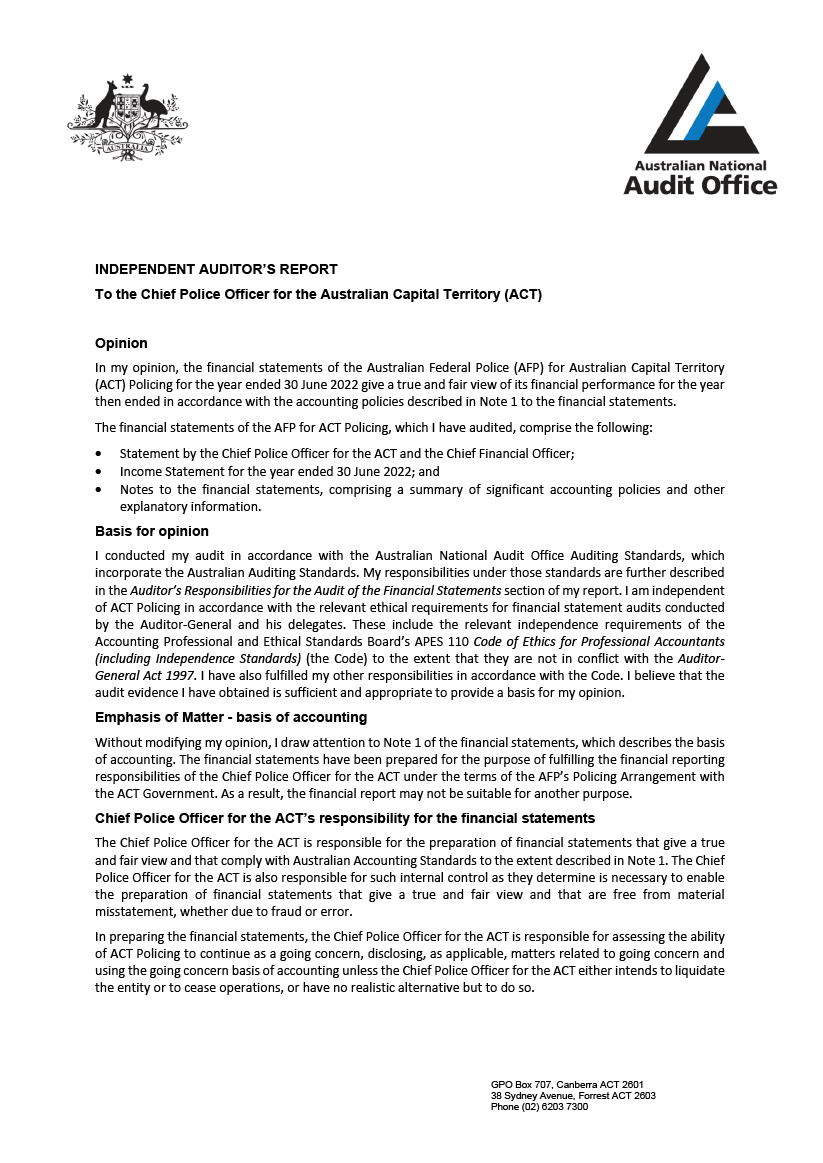
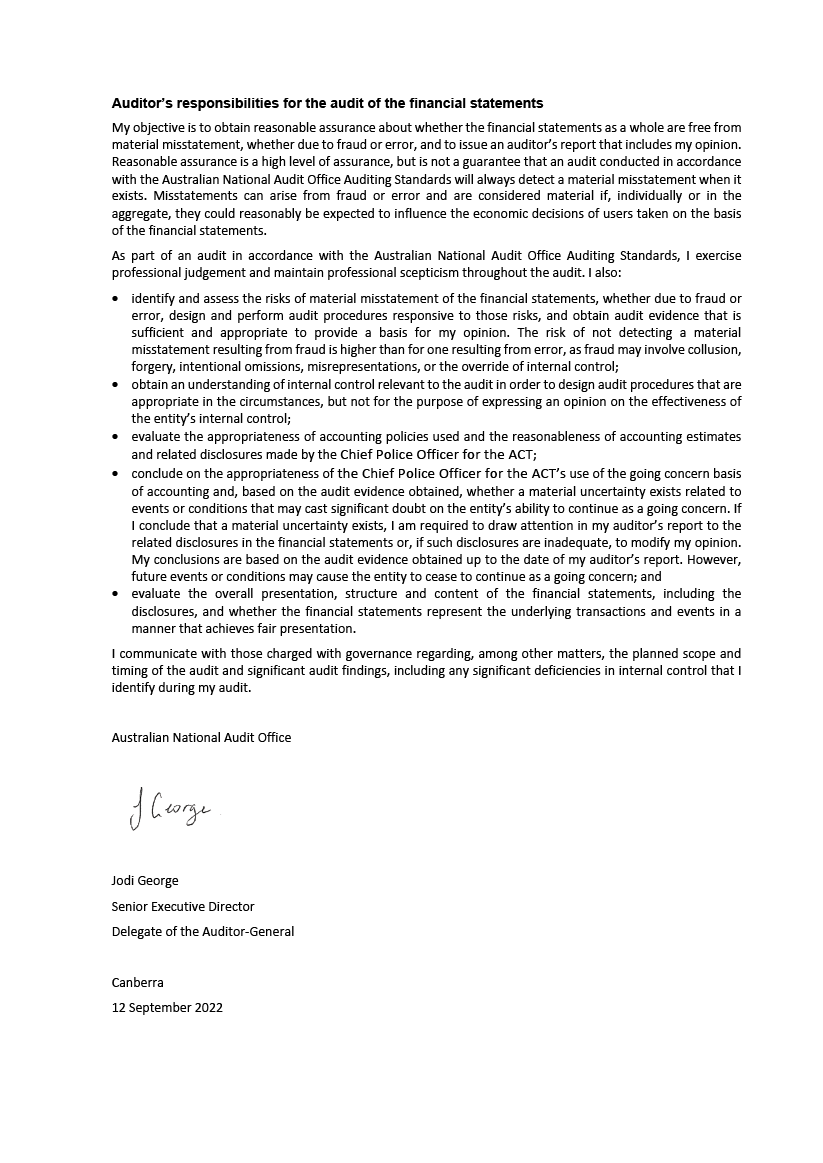
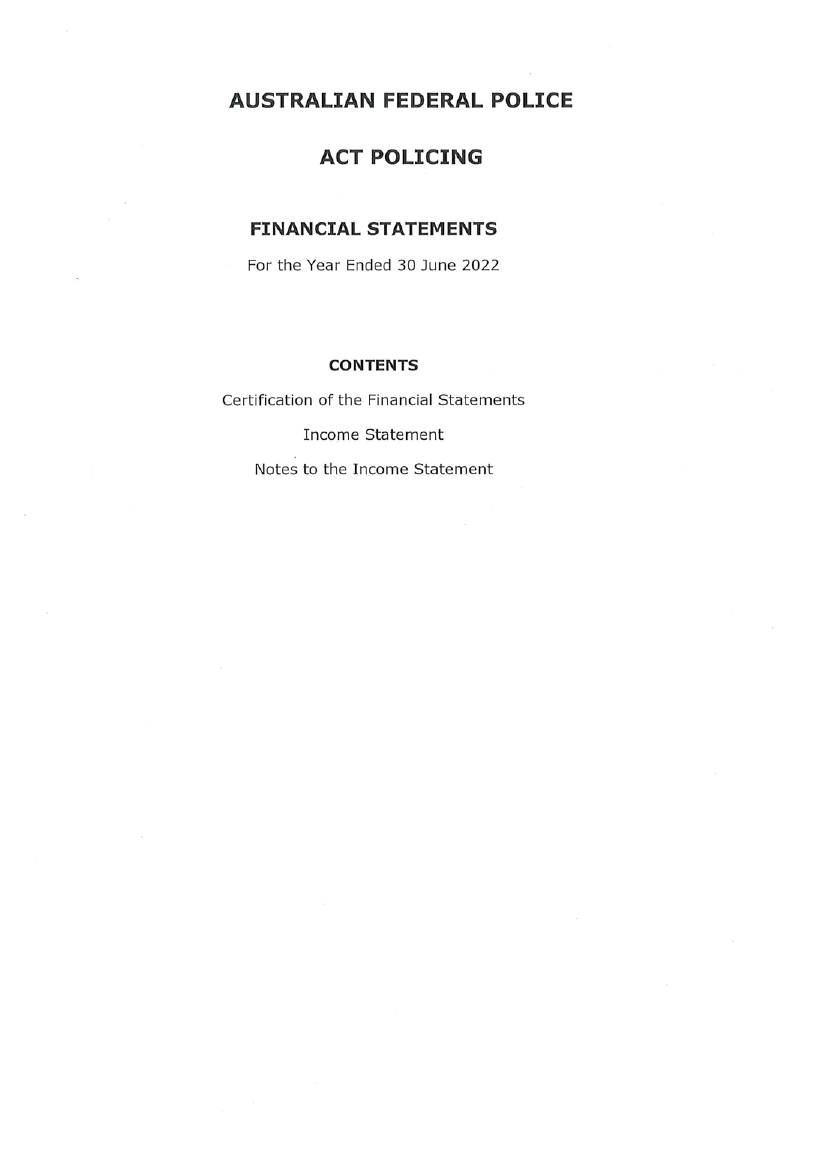
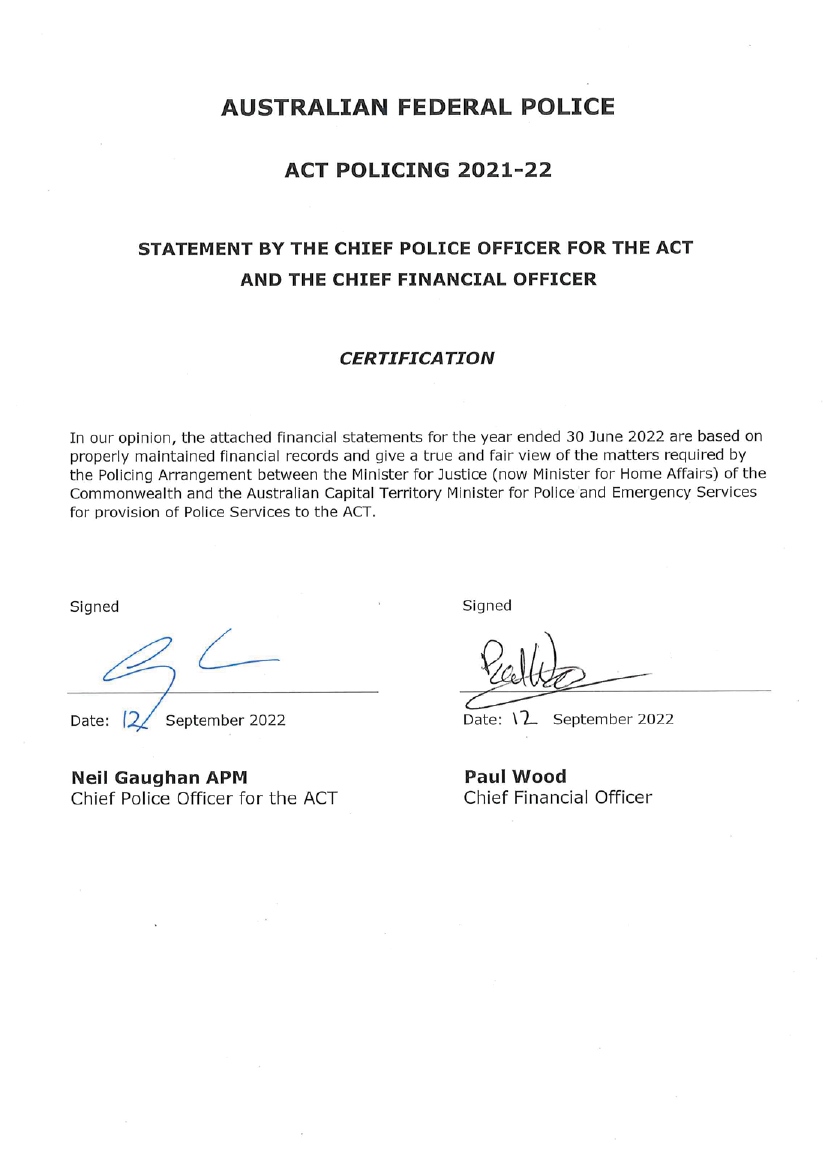
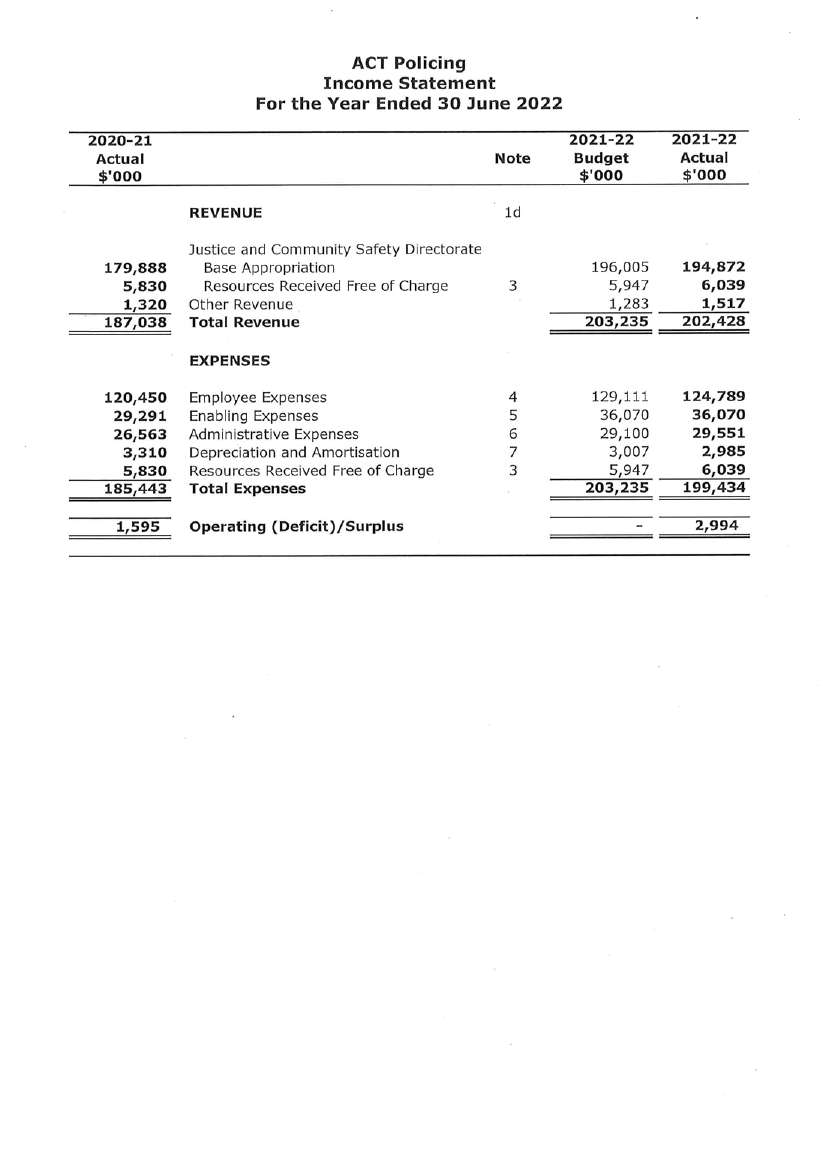
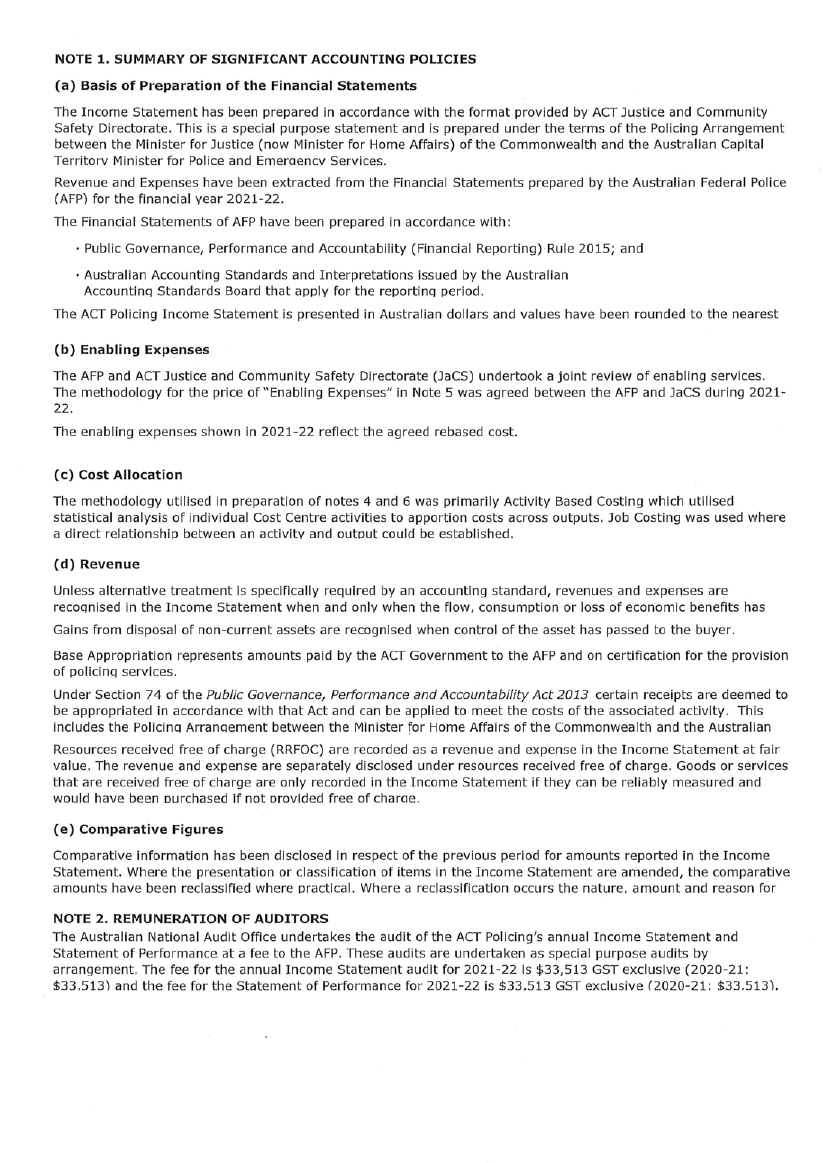
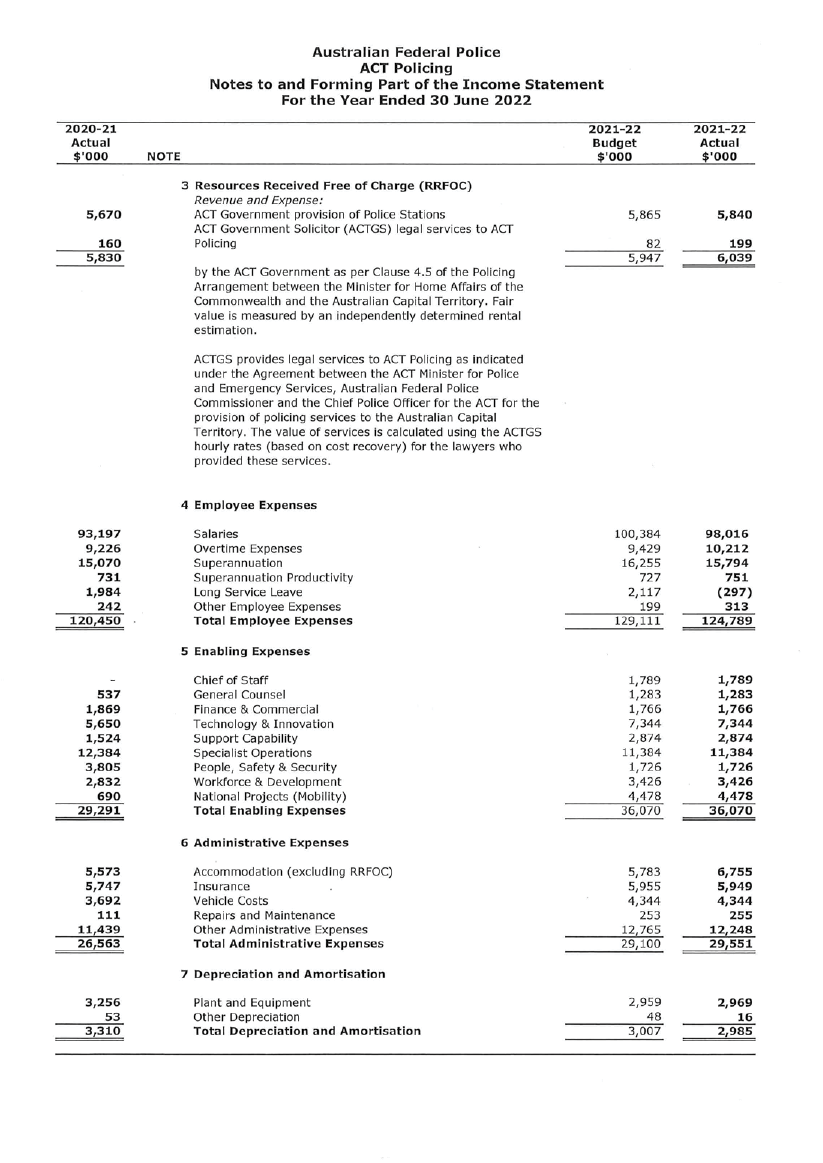
Appendix 2: Statement of Performance
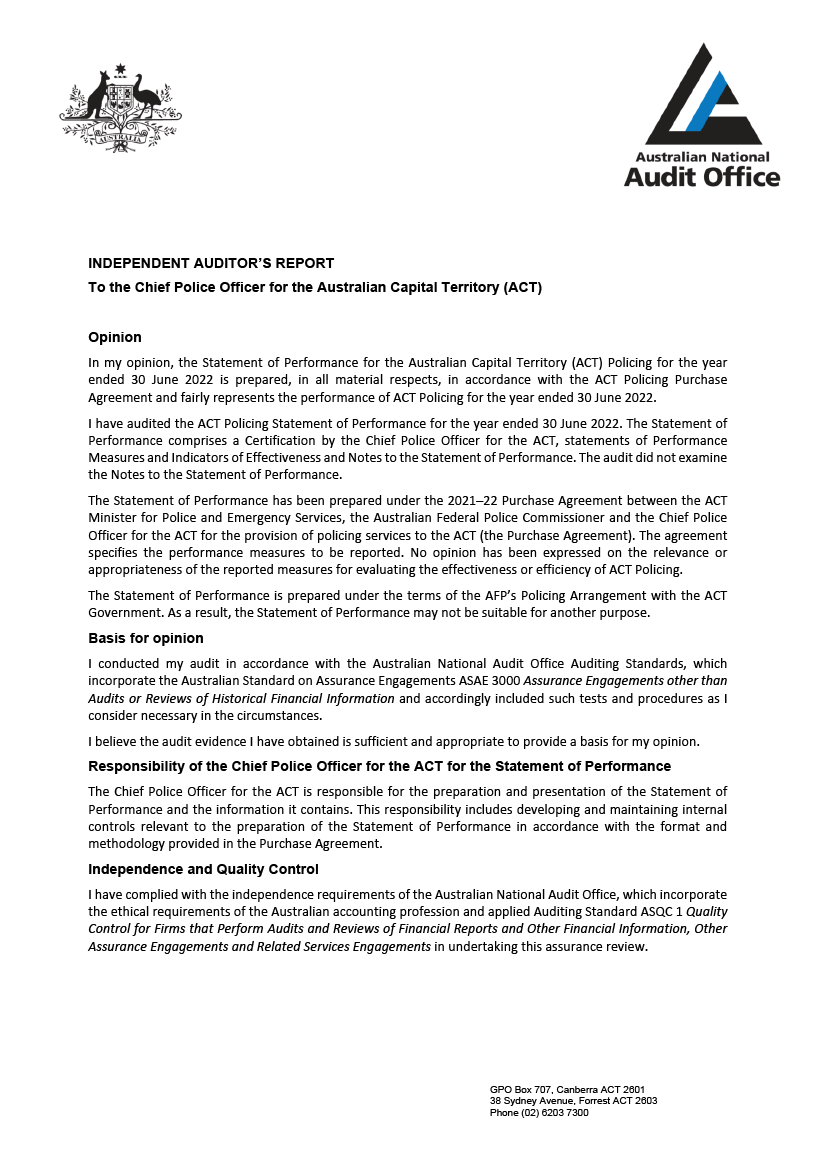


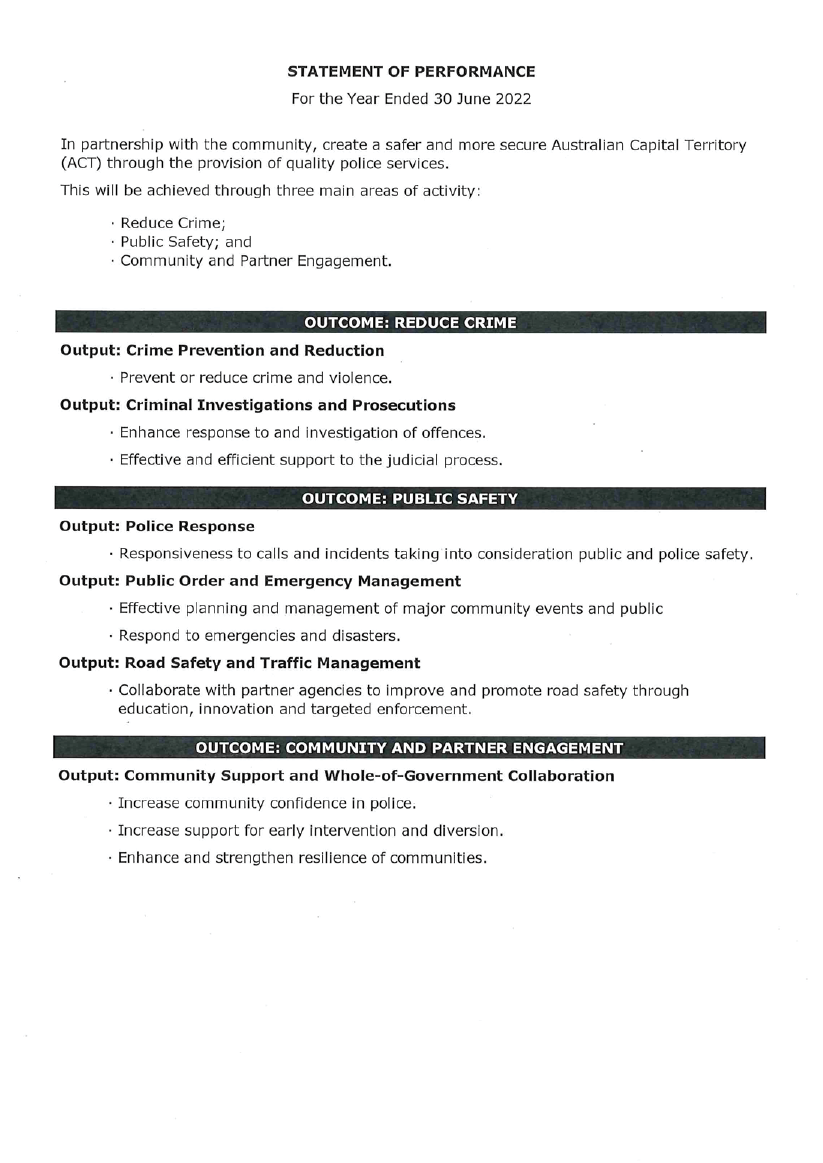
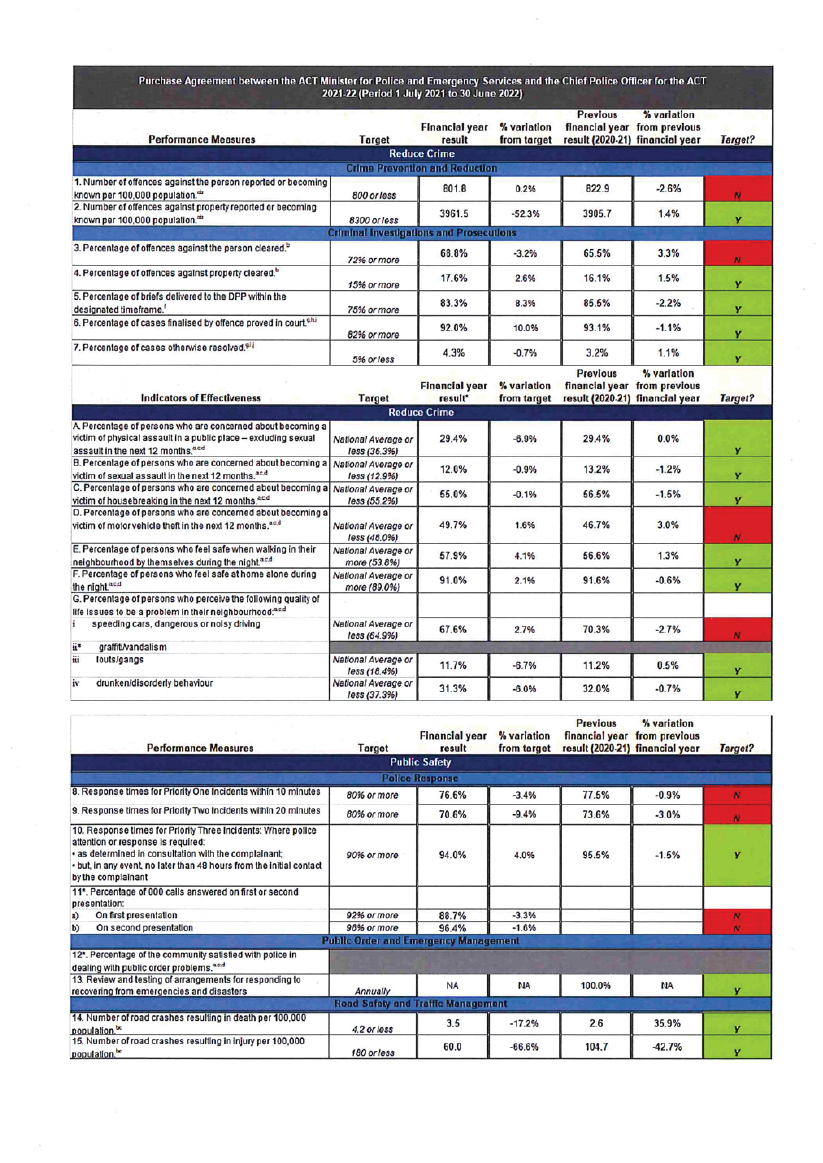
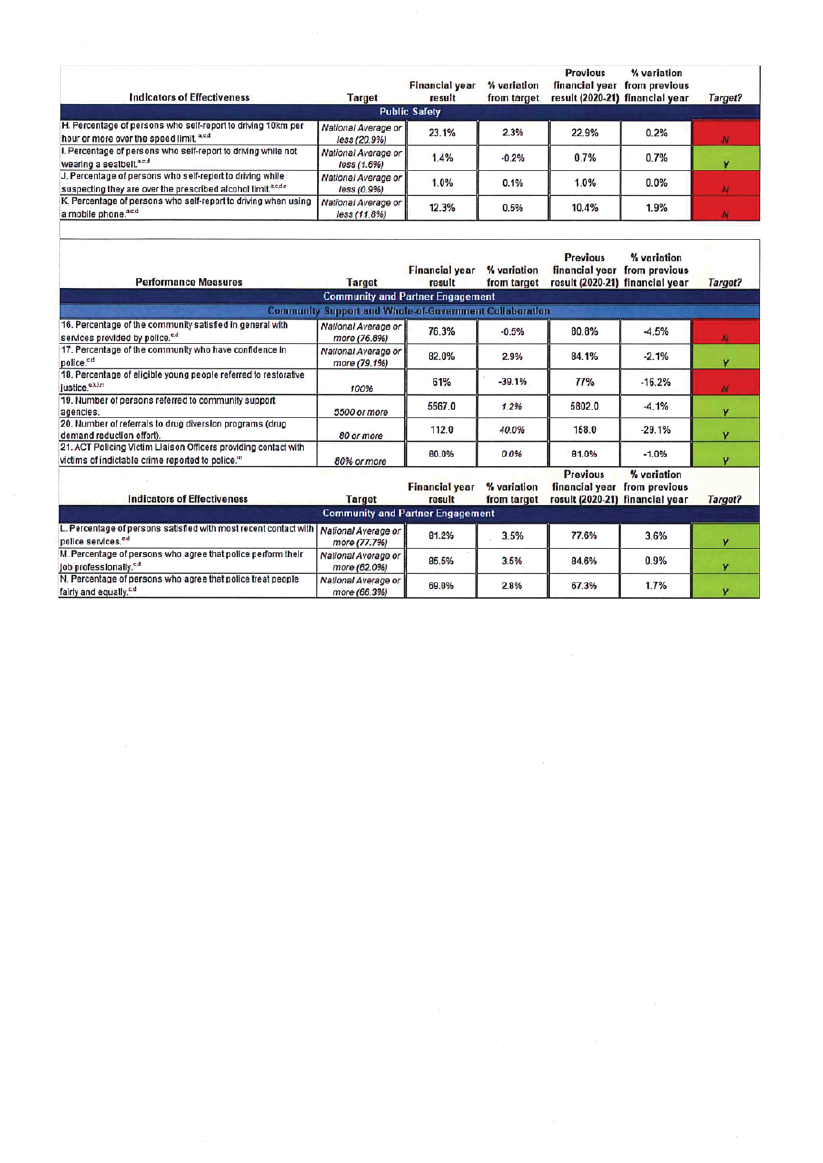
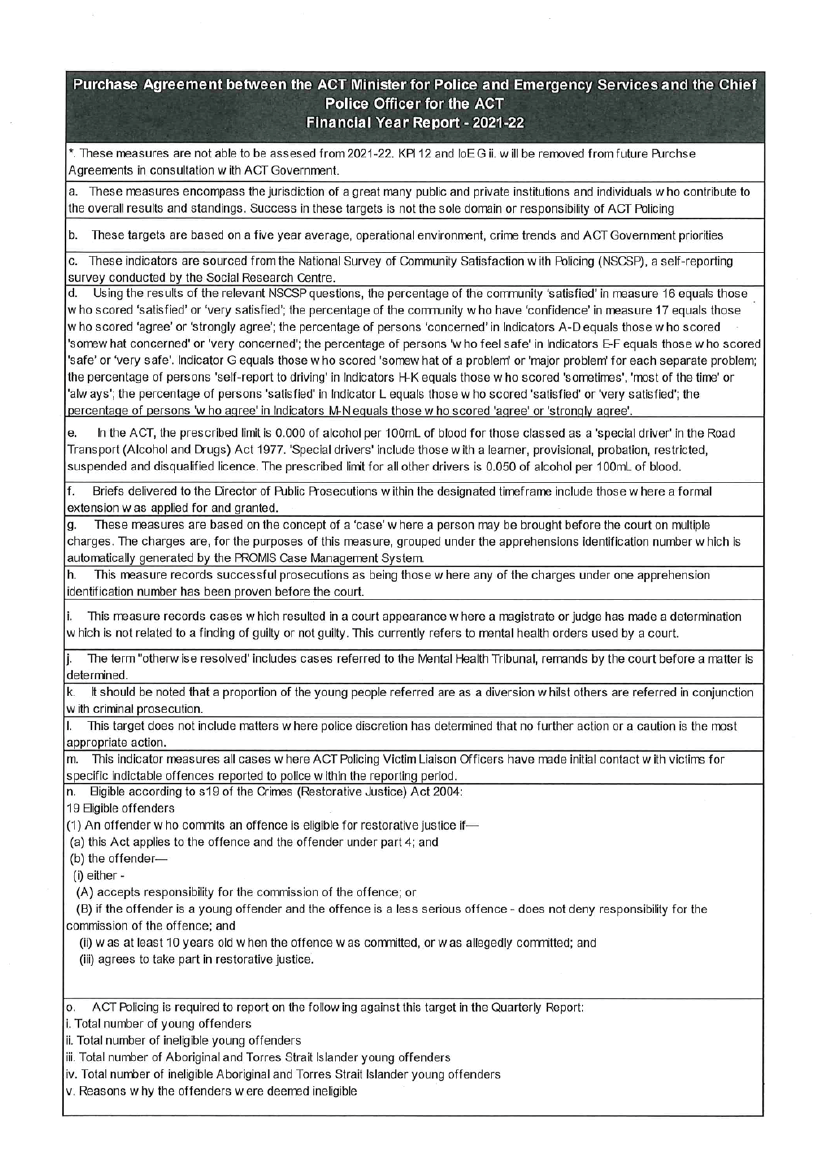
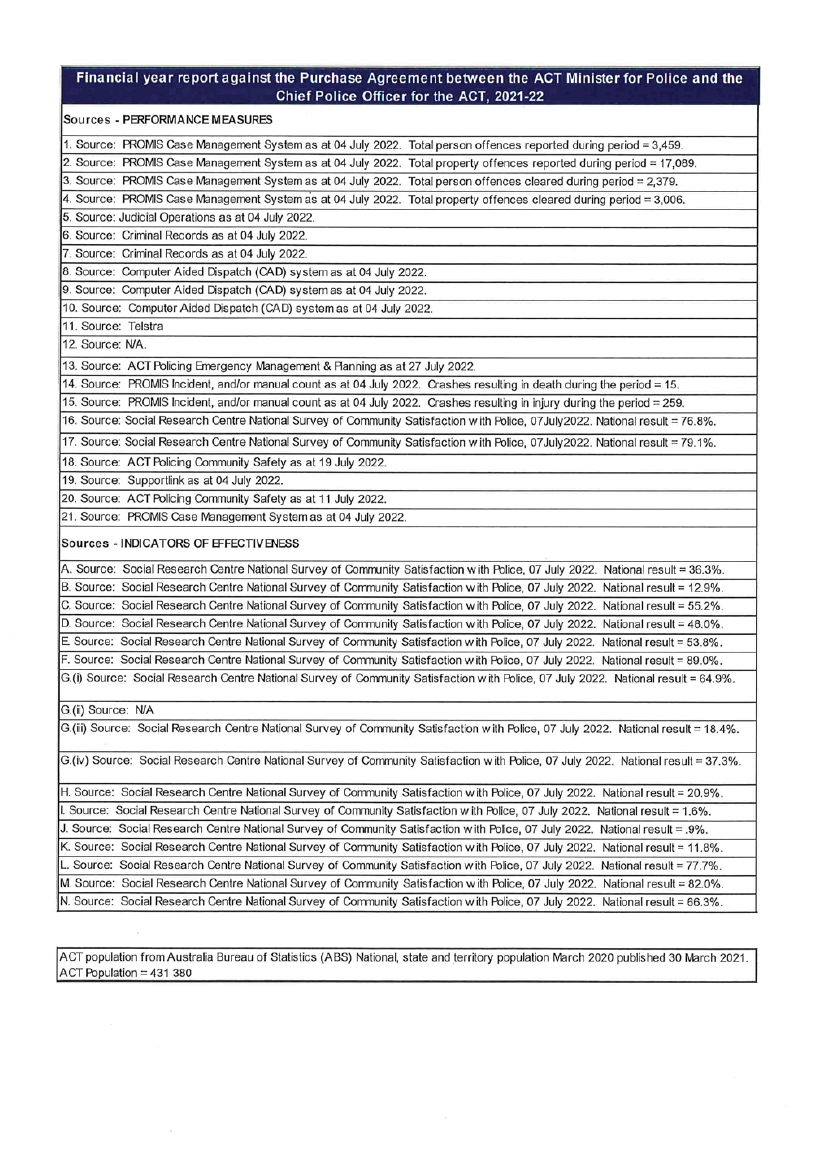
Appendix 3: Number of Offences Reported or Becoming Known in Australian Capital Territory 2017–18 to 2021–22
| Offence type | 2017–18 | 2018–19 | 2019–20 | 2020–21 | 2021–22 |
|---|---|---|---|---|---|
| OFFENCES AGAINST THE PERSON | |||||
| Homicide and Related offences | |||||
| Murder | 3 | 1 | 2 | 5 | 5 |
| Attempted murder | 6 | 5 | 2 | 5 | 1 |
| Conspiracy to murder | - | - | - | 2 | - |
| Manslaughter | - | 1 | 1 | 2 | 3 |
| Driving causing death | 2 | 1 | 1 | 2 | 1 |
| Total Homicide and Related offences | 11 | 8 | 6 | 16 | 10 |
| Assaults (excluding sexual) | |||||
| Assault causing GBH | 93 | 122 | 84 | 101 | 131 |
| Assault causing ABH | 432 | 448 | 454 | 554 | 499 |
| Assault other | 2,322 | 2,380 | 2,289 | 2,221 | 2,039 |
| Total Assaults (excluding sexual) | 2,847 | 2,950 | 2,827 | 2,876 | 2,669 |
| Sexual Offences | |||||
| Sexual assault 1st 2nd 3rd degree | 9 | 22 | 18 | 9 | 4 |
| Sexual intercourse, no consent | 157 | 178 | 154 | 168 | 148 |
| Sexual intercourse, person < 16 years | 68 | 99 | 64 | 80 | 80 |
| Indecent act, assault | 52 | 55 | 51 | 47 | 35 |
| Indecent act, no consent | 125 | 148 | 149 | 138 | 158 |
| Indecent act, person < 16 years | 70 | 92 | 76 | 79 | 51 |
| Incest | 3 | 16 | 11 | 8 | 16 |
| Indecent exposure | 39 | 31 | 32 | 42 | 35 |
| Total Sexual Assault Offences | 523 | 641 | 555 | 571 | 500 |
| Other Offences | |||||
| Kidnap/Abduction | 24 | 24 | 30 | 21 | 23 |
| Other offences against the person | 173 | 247 | 271 | 265 | 252 |
| Total Other Offences | 197 | 271 | 301 | 286 | 275 |
| Total Offences against the Person | 3,578 | 3,870 | 3,689 | 3,749 | 3,454 |
| OFFENCES AGAINST PROPERTY | |||||
| Robbery | |||||
| Armed robbery | 124 | 105 | 108 | 61 | 79 |
| Other robbery | 103 | 109 | 124 | 93 | 82 |
| Total Robbery | 227 | 214 | 232 | 154 | 161 |
| Blackmail and extortion | |||||
| Blackmail and extortion | 17 | 15 | 7 | 6 | 11 |
| Total Blackmail and Extortion | 17 | 15 | 7 | 6 | 11 |
| Burglary | |||||
| Burglary dwellings | 1,678 | 1,659 | 1,392 | 1,172 | 1,086 |
| Burglary shops | 287 | 419 | 377 | 289 | 387 |
| Burglary other | 591 | 548 | 573 | 563 | 540 |
| Total Burglary | 2,556 | 2,626 | 2,342 | 2,024 | 2,013 |
| Fraud and Misappropriation | |||||
| Fraud | 1,387 | 2,037 | 1,577 | 1,791 | 1,998 |
| Misappropriation | - | - | - | - | - |
| Counterfeiting | 60 | 40 | 19 | 16 | 5 |
| Total Fraud and Misappropriation | 1,447 | 2,077 | 1,596 | 1,807 | 2,003 |
| Handling Stolen Goods | |||||
| Receiving | 9 | 4 | 14 | 13 | 3 |
| Unlawful possession | 173 | 109 | 153 | 116 | 102 |
| Other handling stolen goods | 9 | 14 | 11 | 10 | 13 |
| Total Handling of Stolen Goods | 191 | 127 | 178 | 139 | 118 |
| Theft or Illegal use of a Vehicle | |||||
| Motor vehicle theft | 1,494 | 1,244 | 1,297 | 1,402 | 1,478 |
| Total Theft or Illegal use of a Vehicle | 1,494 | 1,244 | 1,297 | 1,402 | 1,478 |
| Other Theft | |||||
| Bicycle theft | 526 | 710 | 717 | 595 | 609 |
| Boat theft | - | 1 | 3 | - | - |
| Stock theft | 2 | - | 2 | - | - |
| Shop stealing | 1,360 | 1,222 | 1,304 | 1,105 | 1,065 |
| Theft at burglary – dwellings | 984 | 940 | 705 | 491 | 410 |
| Theft at burglary – shops | 162 | 226 | 153 | 115 | 147 |
| Theft at burglary – other | 319 | 271 | 262 | 228 | 211 |
| Other theft | 6,443 | 5,378 | 5,124 | 5,329 | 5,260 |
| Total Other Theft | 9,796 | 8,748 | 8,270 | 7,863 | 7,702 |
| Property Damage | |||||
| Arson | 228 | 229 | 215 | 153 | 109 |
| Damage at burglary – dwellings | 131 | 138 | 98 | 76 | 64 |
| Damage at burglary – shops | 36 | 60 | 40 | 21 | 32 |
| Damage at burglary – other | 69 | 61 | 72 | 46 | 50 |
| Other property damage | 4,179 | 4,476 | 3,831 | 3,780 | 3,344 |
| Total Property Damage | 4,643 | 4,964 | 4,256 | 4,076 | 3,599 |
| Environmental Offences | |||||
| Pollution | 6 | 4 | 2 | 4 | 2 |
| Flora and fauna | - | - | 1 | - | - |
| Other environmental offences | 7 | 4 | 4 | 2 | 2 |
| Total Environmental Offences | 13 | 8 | 7 | 6 | 4 |
| Total Offences against Property | 20,384 | 20,023 | 18,185 | 17,477 | 17,089 |
| OFFENCES AGAINST GOOD ORDER | |||||
| Government security/operations | 68 | 135 | 90 | 76 | 70 |
| Justice procedures | 1,889 | 1,792 | 2,101 | 1,853 | 1,554 |
| Firearms and weapons | 403 | 358 | 411 | 321 | 245 |
| Other offences against good order | 896 | 984 | 922 | 773 | 623 |
| Total Offences against Good Order | 3,256 | 3,269 | 3,524 | 3,023 | 2,492 |
| DRUG OFENCES | |||||
| Possess and use drugs | 795 | 560 | 569 | 352 | 236 |
| Deal and supply drugs | 108 | 75 | 69 | 66 | 38 |
| Manufacture and grow drugs | 13 | 20 | 18 | 15 | 10 |
| Other drug offences | 44 | 32 | 39 | 32 | 39 |
| Total Drug Offences | 960 | 687 | 695 | 465 | 313 |
| TRAFFIC OFFENCES | |||||
| Drink driving offences | 1,020 | 1,084 | 833 | 910 | 697 |
| Drug driving offences | 736 | 938 | 808 | 710 | 321 |
| Dangerous and reckless driving | 155 | 178 | 148 | 141 | 93 |
| Driving licence offences | 933 | 954 | 1,041 | 861 | 672 |
| Other motor vehicle, traffic and related offences | 3,873 | 3,550 | 3,793 | 3,477 | 2,416 |
| Total Traffic Offences | 6,717 | 6,704 | 6,623 | 6,099 | 4,199 |
| OTHER OFFENCES NOT ELSEWHERE CLASSIFIED | |||||
| Other offences not elsewhere classified | 252 | 172 | 492 | 285 | 453 |
| All Offences | 35,147 | 34,725 | 33,208 | 31,098 | 28,000 |
Appendix 4: Offences Cleared by ACT Policing in the Australian Capital Territory 2017–18 to 2021–22
| Offence type | 2017–18 | 2018–19 | 2019–20 | 2020–21 | 2021–22 |
|---|---|---|---|---|---|
| OFFENCES AGAINST THE PERSON | |||||
| Homicide and Related offences | |||||
| Murder | 5 | 2 | 1 | 3 | 5 |
| Attempted murder | 4 | 5 | 2 | 5 | 1 |
| Conspiracy to murder | - | - | - | - | 1 |
| Manslaughter | - | 1 | 1 | 1 | 1 |
| Driving causing death | 2 | 1 | - | 2 | 2 |
| Total Homicide and Related offences | 11 | 9 | 4 | 11 | 10 |
| Assaults (excluding sexual) | |||||
| Assault causing GBH | 70 | 98 | 65 | 76 | 108 |
| Assault causing ABH | 316 | 298 | 294 | 329 | 301 |
| Assault other | 1,777 | 1,672 | 1,571 | 1,399 | 1,424 |
| Total Assaults (excluding sexual) | 2,163 | 2,068 | 1,930 | 1,804 | 1,833 |
| Sexual Offences | |||||
| Sexual assault 1st 2nd 3rd degree | 10 | 14 | 10 | 10 | 5 |
| Sexual intercourse, no consent | 118 | 126 | 100 | 101 | 111 |
| Sexual intercourse, person < 16 yrs | 75 | 60 | 55 | 53 | 40 |
| Indecent act, assault | 45 | 27 | 28 | 27 | 19 |
| Indecent act, no consent | 96 | 85 | 90 | 94 | 96 |
| Indecent act, person < 16 yrs | 65 | 74 | 47 | 46 | 51 |
| Incest | 7 | 10 | 8 | 5 | 9 |
| Indecent exposure | 21 | 17 | 14 | 20 | 15 |
| Total Sexual Assault Offences | 437 | 413 | 352 | 356 | 346 |
| Other Offences | |||||
| Kidnap/Abduction | 19 | 17 | 26 | 17 | 22 |
| Other offences against the person | 118 | 157 | 166 | 164 | 163 |
| Total Other Offences | 137 | 174 | 192 | 181 | 185 |
| Total Offences against the Person | 2,748 | 2,664 | 2,478 | 2,352 | 2,374 |
| OFFENCES AGAINST PROPERTY | |||||
| Robbery | |||||
| Armed robbery | 51 | 58 | 37 | 23 | 33 |
| Other robbery | 40 | 35 | 48 | 42 | 38 |
| Total Robbery | 91 | 93 | 85 | 65 | 71 |
| Blackmail and extortion | |||||
| Blackmail and extortion | 4 | 1 | 6 | 4 | - |
| Total Blackmail and Extortion | 4 | 1 | 6 | 4 | - |
| Burglary | |||||
| Burglary dwellings | 183 | 156 | 146 | 144 | 112 |
| Burglary shops | 31 | 44 | 19 | 28 | 26 |
| Burglary other | 64 | 59 | 59 | 44 | 61 |
| Total Burglary | 278 | 259 | 224 | 216 | 199 |
| Fraud and Misappropriation | |||||
| Fraud | 688 | 436 | 610 | 731 | 1,132 |
| Misappropriation | - | - | - | - | - |
| Counterfeiting | 26 | 1 | 4 | 2 | - |
| Total Fraud and Misappropriation | 714 | 437 | 614 | 733 | 1,132 |
| Handling Stolen Goods | |||||
| Receiving | 15 | 2 | 10 | 14 | 4 |
| Unlawful possession | 155 | 82 | 126 | 81 | 83 |
| Other handling stolen goods | 5 | 15 | 9 | 6 | 5 |
| Total Handling of Stolen Goods | 175 | 99 | 145 | 101 | 92 |
| Theft or Illegal use of a Vehicle | |||||
| Motor vehicle theft | 201 | 161 | 168 | 185 | 165 |
| Total Theft or Illegal use of a Vehicle | 201 | 161 | 168 | 185 | 165 |
| Other Theft | |||||
| Bicycle theft | 13 | 15 | 9 | 7 | 8 |
| Boat theft | - | - | - | - | - |
| Stock theft | - | - | - | - | - |
| Shop stealing | 493 | 337 | 323 | 244 | 271 |
| Theft at burglary – dwellings | 101 | 61 | 68 | 43 | 30 |
| Theft at burglary – shops | 14 | 24 | 7 | 13 | 9 |
| Theft at burglary – other | 9 | 14 | 20 | 13 | 29 |
| Other theft | 527 | 464 | 348 | 389 | 339 |
| Total Other Theft | 1,157 | 915 | 775 | 709 | 686 |
| Property Damage | |||||
| Arson | 17 | 11 | 23 | 8 | 15 |
| Damage at burglary – dwellings | 19 | 34 | 8 | 26 | 13 |
| Damage at burglary – shops | 6 | 4 | - | 2 | 6 |
| Damage at burglary – other | 4 | 8 | 12 | 6 | 12 |
| Other property damage | 733 | 687 | 714 | 655 | 613 |
| Total Property Damage | 779 | 744 | 757 | 697 | 659 |
| Environmental Offences | |||||
| Pollution | 5 | 2 | 1 | - | - |
| Flora and fauna | - | - | - | 1 | - |
| Other environmental offences | 5 | 2 | 1 | 1 | 1 |
| Total Environmental Offences | 10 | 4 | 2 | 3 | 1 |
| Total Offences against Property | 3,409 | 2,713 | 2,776 | 2,713 | 3,005 |
| OFFENCES AGAINST GOOD ORDER | |||||
| Government security/operations | 67 | 60 | 76 | 146 | 74 |
| Justice procedures | 1,650 | 1,489 | 1,781 | 1,486 | 1,179 |
| Firearms and weapons | 282 | 284 | 282 | 279 | 201 |
| Other offences against good order | 624 | 673 | 551 | 491 | 380 |
| Total Offences against Good Order | 2,623 | 2,506 | 2,690 | 2,402 | 1,834 |
| DRUG OFENCES | |||||
| Possess and use drugs | 642 | 443 | 410 | 273 | 175 |
| Deal and supply drugs | 82 | 87 | 42 | 51 | 46 |
| Manufacture and grow drugs | 9 | 9 | 8 | 8 | 19 |
| Other drug offences | 11 | 7 | 7 | 2 | 13 |
| Total Drug Offences | 744 | 546 | 467 | 334 | 253 |
| TRAFFIC OFFENCES | |||||
| Drink driving offences | 974 | 1,027 | 758 | 823 | 638 |
| Drug driving offences | 695 | 936 | 779 | 728 | 337 |
| Dangerous and reckless driving | 107 | 129 | 105 | 91 | 75 |
| Driving licence offences | 880 | 857 | 921 | 791 | 598 |
| Other motor vehicle, traffic and related offences | 2,362 | 1,960 | 2,119 | 1,874 | 1,265 |
| Total Traffic Offences | 5,018 | 4,909 | 4,682 | 4,307 | 2,913 |
| OTHER OFFENCES NOT ELSEWHERE CLASSIFIED | |||||
| Other offences not elsewhere classified | 92 | 82 | 125 | 117 | 302 |
| All Offences | 14,634 | 13,420 | 13,218 | 12,225 | 10,681 |
Appendix 5: Percentage of Offences Cleared by ACT Policing 2017–18 to 2021–22
| Offence type | 2017–18 | 2018–19 | 2019–20 | 2020–21 | 2021–22 |
|---|---|---|---|---|---|
| OFFENCES AGAINST THE PERSON | |||||
| Homicide and Related offences | |||||
| Murder | 166.7% | 200.0% | 50.0% | 60.0% | 100.0% |
| Attempted murder | 66.7% | 100.0% | 100.0% | 100.0% | 100.0% |
| Conspiracy to murder | 0.0% | 0.0% | 0.0% | 0.0% | 0.0% |
| Manslaughter | 0.0% | 100.0% | 100.0% | 50.0% | 33.3% |
| Driving causing death | 100.0% | 100.0% | 0.0% | 100.0% | 200.0% |
| Total Homicide and Related offences | 100.0% | 112.5% | 66.7% | 68.8% | 100.0% |
| Assaults (excluding sexual) | |||||
| Assault causing GBH | 75.3% | 80.3% | 77.4% | 75.2% | 82.4% |
| Assault causing ABH | 73.1% | 66.5% | 64.8% | 59.4% | 60.3% |
| Assault other | 76.5% | 70.3% | 68.6% | 63.0% | 69.8% |
| Total Assaults (excluding sexual) | 76.0% | 70.1% | 68.3% | 62.7% | 68.7% |
| Sexual Offences | |||||
| Sexual assault 1st 2nd 3rd degree | 111.1% | 63.6% | 55.6% | 111.1% | 125.0% |
| Sexual intercourse, no consent | 75.2% | 70.8% | 64.9% | 60.1% | 75.0% |
| Sexual intercourse, person < 16 yrs | 110.3% | 60.6% | 85.9% | 66.3% | 75.5% |
| Indecent act, assault | 86.5% | 49.1% | 54.9% | 57.4% | 54.3% |
| Indecent act, no consent | 76.8% | 57.4% | 60.4% | 68.1% | 60.8% |
| Indecent act, person < 16 yrs | 92.9% | 80.4% | 61.8% | 58.2% | 100.0% |
| Incest | 233.3% | 62.5% | 72.7% | 62.5% | 56.3% |
| Indecent exposure | 53.8% | 54.8% | 43.8% | 47.6% | 42.9% |
| Total Sexual Assault Offences | 83.6% | 64.4% | 63.4% | 62.3% | 69.2% |
| Other Offences | |||||
| Kidnap/Abduction | 79.2% | 70.8% | 86.7% | 81.0% | 95.7% |
| Other offences against the person | 68.2% | 63.6% | 61.3% | 61.9% | 64.7% |
| Total Other Offences | 69.5% | 64.2% | 63.8% | 63.3% | 67.3% |
| Total Offences against the Person | 76.8% | 68.8% | 67.2% | 62.7% | 68.7% |
| OFFENCES AGAINST PROPERTY | |||||
| Robbery | |||||
| Armed robbery | 41.1% | 55.2% | 34.3% | 37.7% | 41.8% |
| Other robbery | 38.8% | 32.1% | 38.7% | 45.2% | 46.3% |
| Total Robbery | 40.1% | 43.5% | 36.6% | 42.2% | 44.1% |
| Blackmail and extortion | |||||
| Blackmail and extortion | 23.5% | 6.7% | 85.7% | 66.7% | 0.0% |
| Total Blackmail and Extortion | 23.5% | 6.7% | 85.7% | 66.7% | 0.0% |
| Burglary | |||||
| Burglary dwellings | 10.9% | 9.4% | 10.5% | 12.3% | 10.3% |
| Burglary shops | 10.8% | 10.5% | 5.0% | 9.7% | 6.7% |
| Burglary other | 10.8% | 10.8% | 10.3% | 7.8% | 11.3% |
| Total Burglary | 10.9% | 9.9% | 9.6% | 10.7% | 9.9% |
| Fraud and Misappropriation | |||||
| Fraud | 49.6% | 21.4% | 38.7% | 40.8% | 56.7% |
| Misappropriation | 0.0% | 0.0% | 0.0% | 0.0% | 0.0% |
| Counterfeiting | 43.3% | 2.5% | 21.1% | 12.5% | 0.0% |
| Total Fraud and Misappropriation | 49.3% | 21.0% | 38.5% | 40.6% | 56.5% |
| Handling Stolen Goods | |||||
| Receiving | 166.7% | 50.0% | 71.4% | 107.7% | 133.3% |
| Unlawful possession | 89.6% | 75.2% | 82.4% | 69.8% | 81.4% |
| Other handling stolen goods | 55.6% | 107.1% | 81.8% | 60.0% | 38.5% |
| Total Handling of Stolen Goods | 91.6% | 78.0% | 81.5% | 72.7% | 78.0% |
| Theft or Illegal use of a Vehicle | |||||
| Motor vehicle theft | 13.5% | 12.9% | 13.0% | 13.2% | 11.2% |
| Total Theft or Illegal use of a Vehicle | 13.5% | 12.9% | 13.0% | 13.2% | 11.2% |
| Other Theft | |||||
| Bicycle theft | 2.5% | 2.1% | 1.3% | 1.2% | 1.3% |
| Boat theft | 0.0% | 0.0% | 0.0% | 0.0% | 0.0% |
| Stock theft | 0.0% | 0.0% | 0.0% | 0.0% | 0.0% |
| Shop stealing | 36.3% | 27.6% | 24.8% | 22.1% | 25.4% |
| Theft at burglary – dwellings | 10.3% | 6.5% | 9.6% | 8.8% | 7.3% |
| Theft at burglary – shops | 8.6% | 10.6% | 4.6% | 11.3% | 6.1% |
| Theft at burglary – other | 2.8% | 5.2% | 7.6% | 5.7% | 13.7% |
| Other theft | 8.2% | 8.6% | 6.8% | 7.3% | 6.4% |
| Total Other Theft | 11.8% | 10.5% | 9.4% | 9.0% | 8.9% |
| Property Damage | |||||
| Arson | 7.5% | 4.8% | 10.7% | 5.2% | 13.8% |
| Damage at burglary – dwellings | 14.5% | 24.6% | 8.2% | 34.2% | 20.3% |
| Damage at burglary – shops | 16.7% | 6.7% | 0.0% | 9.5% | 18.8% |
| Damage at burglary – other | 5.8% | 13.1% | 16.7% | 13.0% | 24.0% |
| Other property damage | 17.5% | 15.3% | 18.6% | 17.3% | 18.3% |
| Total Property Damage | 16.8% | 15.0% | 17.8% | 17.1% | 18.3% |
| Environmental Offences | |||||
| Pollution | 83.3% | 50.0% | 50.0% | 25.0% | 0.0% |
| Flora and fauna | 0.0% | 0.0% | 0.0% | 100.0% | 0.0% |
| Other environmental offences | 71.4% | 50.0% | 25.0% | 50.0% | 50.0% |
| Total Environmental Offences | 76.9% | 50.0% | 28.6% | 50.0% | 25.0% |
| Total Offences against Property | 16.7% | 13.5% | 15.3% | 15.5% | 17.6% |
| OFFENCES AGAINST GOOD ORDER | |||||
| Government security/operations | 98.5% | 44.4% | 84.4% | 192.1% | 105.7% |
| Justice procedures | 87.3% | 83.1% | 84.8% | 80.2% | 75.9% |
| Firearms and weapons | 70.0% | 79.3% | 68.6% | 86.9% | 82.0% |
| Other offences against good order | 69.6% | 68.4% | 59.8% | 63.5% | 61.0% |
| Total Offences against Good Order | 80.6% | 76.7% | 76.3% | 79.5% | 73.6% |
| DRUG OFENCES | |||||
| Possess and use drugs | 80.8% | 79.1% | 72.1% | 77.6% | 74.2% |
| Deal and supply drugs | 75.9% | 116.0% | 60.9% | 77.3% | 121.1% |
| Manufacture and grow drugs | 69.2% | 45.0% | 44.4% | 53.3% | 190.0% |
| Other drug offences | 25.0% | 21.9% | 17.9% | 6.3% | 44.8% |
| Total Drug Offences | 77.5% | 79.5% | 67.2% | 71.8% | 80.8% |
| TRAFFIC OFFENCES | |||||
| Drink driving offences | 95.5% | 94.7% | 91.0% | 90.4% | 91.5% |
| Drug driving offences | 94.4% | 99.8% | 96.4% | 102.5% | 105.0% |
| Dangerous and reckless driving | 69.0% | 72.5% | 70.9% | 64.5% | 80.6% |
| Driving licence offences | 94.3% | 89.8% | 88.5% | 91.9% | 89.0% |
| Other motor vehicle, traffic and related offences | 61.0% | 55.2% | 55.9% | 53.9% | 52.4% |
| Total Traffic Offences | 74.7% | 73.2% | 70.7% | 70.6% | 69.4% |
| OTHER OFFENCES NOT ELSEWHERE CLASSIFIED | |||||
| Other offences not elsewhere classified | 36.5% | 47.7% | 25.4% | 41.1% | 66.7% |
| All Offences | 41.6% | 38.6% | 39.8% | 39.3% | 38.1% |
Appendix 6: Proceedings Against Offenders by ACT Policing (Charges) 2017–18 to 2021–22
| Offence type | 2017–18 | 2018–19 | 2019–20 | 2020–21 | 2021–22 |
|---|---|---|---|---|---|
| OFFENCES AGAINST THE PERSON | |||||
| Homicide and Related offences | |||||
| Murder | 7 | 3 | 1 | 4 | 4 |
| Attempted murder | 4 | 10 | - | 8 | 5 |
| Conspiracy to murder | - | - | - | 4 | - |
| Manslaughter | - | 1 | 1 | 2 | 1 |
| Driving causing death | 3 | 1 | - | 3 | 1 |
| Total Homicide and Related offences | 14 | 15 | 2 | 21 | 11 |
| Assaults (excluding sexual) | |||||
| Assault causing GBH | 127 | 169 | 150 | 152 | 177 |
| Assault causing ABH | 316 | 325 | 331 | 372 | 389 |
| Assault other | 976 | 954 | 1,029 | 912 | 937 |
| Total Assaults (excluding sexual) | 1,419 | 1,448 | 1,510 | 1,436 | 1,503 |
| Sexual Offences | |||||
| Sexual assault 1st 2nd 3rd degree | 7 | 20 | 37 | 33 | 54 |
| Sexual intercourse, no consent | 27 | 23 | 24 | 19 | 76 |
| Sexual intercourse, person < 16 yrs | 35 | 48 | 75 | 18 | 34 |
| Indecent act, assault | 2 | - | 2 | - | 1 |
| Indecent act, no consent | 79 | 93 | 63 | 95 | 64 |
| Indecent act, person < 16 yrs | 53 | 48 | 34 | 25 | 76 |
| Incest | 1 | 14 | 1 | 8 | 3 |
| Indecent exposure | - | - | - | - | - |
| Total Sexual Assault Offences | 204 | 246 | 236 | 198 | 308 |
| Other Offences | |||||
| Kidnap/Abduction | 28 | 30 | 27 | 23 | 47 |
| Other offences against the person | 185 | 210 | 235 | 258 | 255 |
| Total Other Offences | 213 | 240 | 262 | 281 | 302 |
| Total Offences against the Person | 1,850 | 1,949 | 2,010 | 1,936 | 2,124 |
| OFFENCES AGAINST PROPERTY | |||||
| Robbery | |||||
| Armed robbery | 55 | 99 | 55 | 40 | 69 |
| Other robbery | 58 | 59 | 73 | 49 | 44 |
| Total Robbery | 113 | 158 | 128 | 89 | 113 |
| Blackmail and extortion | |||||
| Blackmail and extortion | 5 | 8 | 2 | 5 | 5 |
| Total Blackmail and Extortion | 5 | 8 | 2 | 5 | 5 |
| Burglary | |||||
| Burglary dwellings | 194 | 182 | 152 | 142 | 133 |
| Burglary shops | 39 | 51 | 68 | 37 | 31 |
| Burglary other | 106 | 117 | 124 | 86 | 85 |
| Total Burglary | 339 | 350 | 344 | 265 | 249 |
| Fraud and Misappropriation | |||||
| Fraud | 699 | 347 | 893 | 962 | 585 |
| Misappropriation | 4 | - | - | - | 2 |
| Counterfeiting | - | 1 | 4 | 2 | - |
| Total Fraud and Misappropriation | 703 | 348 | 897 | 964 | 587 |
| Handling Stolen Goods | |||||
| Receiving | 35 | 14 | 29 | 21 | 25 |
| Unlawful possession | 293 | 182 | 357 | 283 | 233 |
| Other handling stolen goods | 10 | 5 | 8 | 2 | 1 |
| Total Handling of Stolen Goods | 338 | 201 | 394 | 306 | 259 |
| Theft or Illegal use of a Vehicle | |||||
| Motor vehicle theft | 302 | 320 | 292 | 295 | 296 |
| Total Theft or Illegal use of a Vehicle | 302 | 320 | 292 | 295 | 296 |
| Other Theft | |||||
| Bicycle theft | 10 | 15 | 23 | 10 | 10 |
| Boat theft | - | - | - | - | - |
| Stock theft | - | - | - | - | - |
| Shop stealing | 239 | 263 | 266 | 234 | 225 |
| Theft at burglary – dwellings | 84 | 85 | 161 | 70 | 82 |
| Theft at burglary – shops | 20 | 32 | 25 | 17 | 8 |
| Theft at burglary – other | 23 | 39 | 61 | 17 | 25 |
| Other theft | 305 | 250 | 462 | 305 | 323 |
| Total Other Theft | 681 | 684 | 998 | 653 | 673 |
| Property Damage | |||||
| Arson | 23 | 25 | 25 | 15 | 28 |
| Damage at burglary – dwellings | 37 | 56 | 84 | 70 | 47 |
| Damage at burglary – shops | 6 | 16 | 22 | 5 | 4 |
| Damage at burglary – other | 18 | 44 | 34 | 14 | 8 |
| Other property damage | 540 | 564 | 525 | 518 | 547 |
| Total Property Damage | 624 | 705 | 690 | 622 | 634 |
| Environmental Offences | |||||
| Pollution | 4 | - | - | 2 | - |
| Flora and fauna | 1 | - | 2 | - | 1 |
| Other environmental offences | 1 | 2 | 2 | - | - |
| Total Environmental Offences | 6 | 2 | 4 | 2 | 1 |
| Total Offences against Property | 3,111 | 2,776 | 3,749 | 3,201 | 2,817 |
| OFFENCES AGAINST GOOD ORDER | |||||
| Government security/operations | 193 | 116 | 278 | 132 | 110 |
| Justice procedures | 2,445 | 2,411 | 2,779 | 2,617 | 2,114 |
| Firearms and weapons | 421 | 488 | 469 | 421 | 338 |
| Other offences against good order | 582 | 598 | 655 | 577 | 532 |
| Total Offences against Good Order | 3,641 | 3,613 | 4,181 | 3,747 | 3,094 |
| DRUG OFENCES | |||||
| Possess and use drugs | 818 | 565 | 510 | 314 | 238 |
| Deal and supply drugs | 163 | 83 | 47 | 43 | 43 |
| Manufacture and grow drugs | 17 | 21 | 10 | 17 | 13 |
| Other drug offences | 1 | - | - | 4 | 2 |
| Total Drug Offences | 999 | 669 | 567 | 378 | 296 |
| TRAFFIC OFFENCES | |||||
| Drink driving offences | 1,082 | 1,161 | 881 | 956 | 764 |
| Drug driving offences | 814 | 1,021 | 878 | 788 | 389 |
| Dangerous and reckless driving | 165 | 160 | 175 | 164 | 165 |
| Driving licence offences | 1,248 | 1,218 | 1,274 | 1,196 | 911 |
| Other motor vehicle, traffic and related offences | 1,420 | 1,335 | 1,393 | 1,299 | 882 |
| Total Traffic Offences | 4,729 | 4,895 | 4,601 | 4,403 | 3,111 |
| OTHER OFFENCES NOT ELSEWHERE CLASSIFIED | |||||
| Other offences not elsewhere classified | 298 | 175 | 159 | 223 | 338 |
| All Offences | 14,628 | 14,077 | 15,267 | 13,888 | 11,780 |
Appendix 7: Abbreviations
| Abbreviation | Meaning |
|---|---|
| ABC | Australian Broadcasting Corporation |
| ACLEI | Australian Commission for Law Enforcement Integrity |
| ACT | Australian Capital Territory |
| ADF | Australian Defence Force |
| AFP | Australian Federal Police |
| BWC | body worn cameras |
| CANS | Court Attendance Notices |
| CCTV | closed circuit television |
| CEW | conducted electrical weapon |
| CKK | Constable Kenny Koala |
| CMT | Complaints Management Team |
| CO3 | AFP Commissioner’s Order 3 |
| CPO | Chief Police Officer |
| Cth | Commonwealth |
| DPP | Director of Public Prosecutions |
| EDT | Early Diversion Team |
| EPIC | Exhibition Park in Canberra |
| FTE | full-time equivalent |
| FVU | Family Violence Unit |
| 4WD | four-wheel drive |
| IMG | Issues Motivated Group |
| IoE | Indicators of Effectiveness |
| JaCS | Justice and Community Safety Directorate |
| NSCSP | National Survey of Community Satisfaction with Policing |
| NSW | New South Wales |
| NSWPF | New South Wales Police Force |
| OMG | outlaw motorcycle gang |
| PACER | Police, Ambulance and Clinician Early Response |
| PROMIS | AFP’s case management system |
| PRS | ACT Policing Professional Standards |
| PSM | Police Services Model |
| PSO | Protective Services Officer |
| RJ | restorative justice |
| RJU | Justice and Community Safety Directorate Restorative Justice Unit |
| RR25by25 | Reducing Recidivism by 25 per cent by 2025 Policy |
| SACAT | Sexual Assault and Child Abuse Team |
| SES | Senior Executive Service |
| SHIELD | AFP Police Health Model, delivering health and wellbeing services to members |
| VLO | Victim Liaison Officer |
